 10/04/2009 16:24 10/04/2009 16:24 |
|
| | | OFFLINE | | Post: 17.103 | Registrato il: 28/08/2005
| Utente Gold | |
|
OREMUS PRO PONTEFICE NOSTRO
The Holy Father requests the prayers of all the faithful so that the Lord may illumine the road for the Church. May the commitment of Pastors and the faithful grow, in support of the delicate and weighty mission of the Successor of the Apostle Peter as 'the guardian of unity' in the Church.
- Vatican Note, Feb. 4, 2009
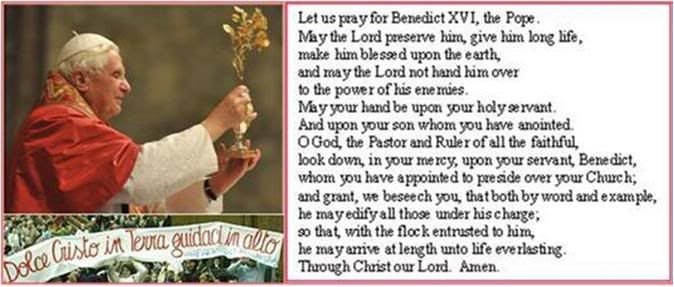

Because of the page change, I rearranged my posts earlier today to have the Good Friday schedule and the story on the L'Aquila funerals on this page. In place of the L'Aquila story earlier, I posted a follow-up story on the Pope's AIDS sstatements from the new Archbishop of Westminster.


April 10
Good Friday
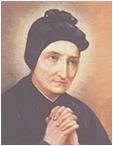 St. Magdalen of Canossa (1774-1835)
St. Magdalen of Canossa (1774-1835)
Founder, Congregation of
the Daughters of Charity
OR today.
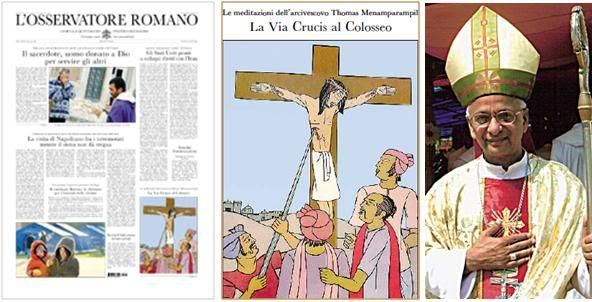
The issue carries the full text of Archbishop Thomas Menamparampil's meditations
and prayers for the Via Crucis at the Colosseum tonight.
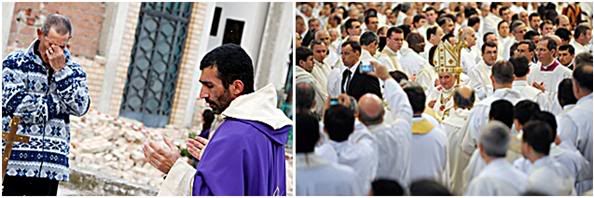
At the Chrismal Mass yesterday, Benedict XVI asks priests
to let themselves be guided by the Gospel:
'The priest, a man given by God to serve others'
(Left photo shows a priest ministering to earthquale victims in L'Aquila)
Other Page 1 stories: President Napolitano's visit to the earthquake victims; Cardinal Bertone to offer
funeral Mass at L'Aquila today for earthquake dead; and the United States ready for direct talks with Iran,
even as Iran celebrates its National Nuclear Day and Ahmadinejad boasts of progress in nuclear program.
THE POPE'S DAY

April 10
Good Friday
CELEBRATION OF THE PASSION OF THE LORD
Cappella Papale
17:00, St. Peter's Basilica
The Holy Father will preside at the Liturgy of the Word, Adoration of the Cross and the Communion rite.
VIA CRUCIS
21:15, Colosseum
The Holy Father will preside at the Stations of the Cross, after which he will address the faithful
and impart the Apostolic Blessing.
[Modificato da TERESA BENEDETTA 10/04/2009 17:01] |
|
 10/04/2009 16:51 10/04/2009 16:51 |
|
| | | OFFLINE | | Post: 17.104 | Registrato il: 28/08/2005
| Utente Gold | |
|
 Pope urges earthquake survivors
Pope urges earthquake survivors
to keep up hope

L'AQUILA, Italy, April 10 (AP) – Pope Benedict XVI has urged quake-stricken people to have courage and keep up hope.
The Pope told the survivors that he felt "spiritually among you" and that he was sharing their anguish.
The message was read Friday by the Pope's secretary, Monsignor Georg Gaenswein, at the opening of a collective funeral for 205 victims of the quake.
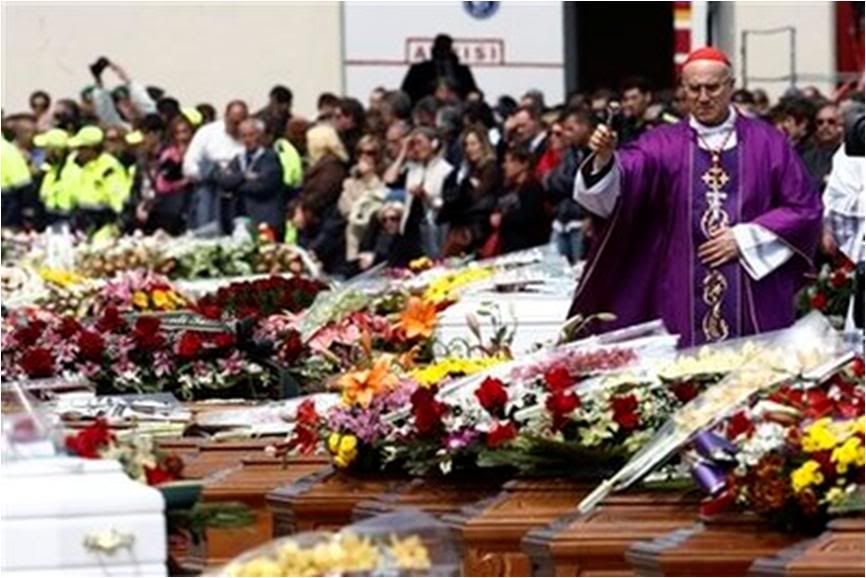
The Pope sent Cardinal Tarcisio Bertone, Vatican secretary of state, to preside at the funeral Mass.
Benedict plans to visit the quake area in the coming weeks.
The Vatican granted a special dispensation to hold a Mass on Good Friday, the only day on the Roman Catholic calendar on which Mass is not normally celebrated.
Cardinal Bertone and Mons. Gaenswein arriving in L'Aquila earlier today:

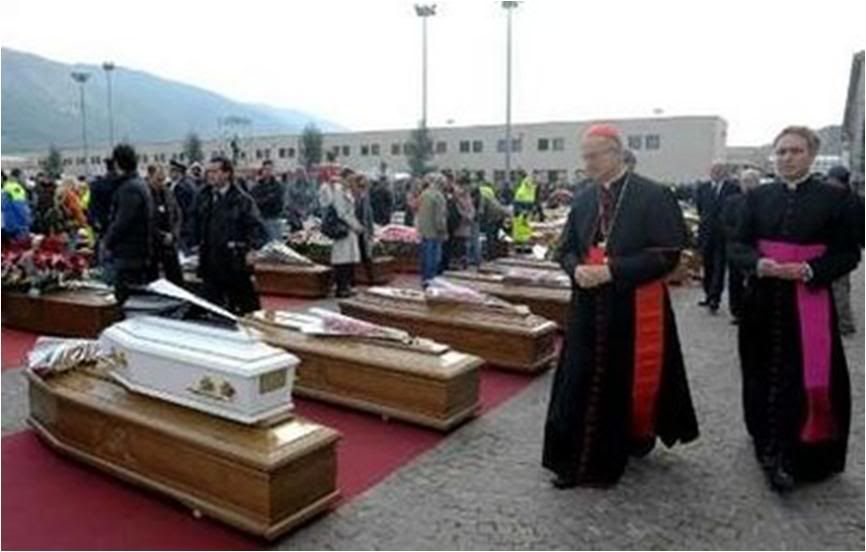 MESSAGE OF THE HOLY FATHER
MESSAGE OF THE HOLY FATHER
FOR THE FUNERAL MASS AT L'AQUILA
Translated from

Here is the text of the message sent by the Holy Father Benedict XVI to the Archbishop of L'Aquila, Mons. Giuseppe Molinari, which Mons. Georg Gaenswein read at the start of the funeral Mass for victims of the earthquake:
To my dear Archbishop Molinari and all of you,
dearest brothers and sisters in the Lord:
In these tragic time when an immense tragedy has fallen on your land, I feel myself spiritually present among you to share your anguish, to ask God to grant eternal rest to the victims, quick recovery for the injured, and for everyone, the courage to continue in hope without yielding to despondency.
I asked my Secretary of State to preside at this extraordinary liturgical celebration at which the Christian community gathers around their dead to give them the last farewell.
I entrust to him and to my private secretary the task of bringing you in person the expression of my sorrowful participation in the grief of those who mourn dear ones taken down by this disaster.
At moments like these, faith remains the source of light and hope, especially during these days which speak of the suffering of the Son of God who became man for us: May his passion, his death and his resurrection, be for all a fountain of comfort, and open the heart of each one to the contemplation of that life when "there shall be no more death or mourning, wailing or pain, (for) the old order has passed away" (Ap 21,4).
I am sure that with the commitment of everyone, we can face the most impelling necessities. The violence of the quake has created situations of singular difficulty.
I have followed the developments in this devastating telluric phenomenon from the first moments, which were felt even in the Vatican, and I have noted the growing wave of solidarity with which aid and rescue work have been organized, towards even more incisive actions by institutions of the State and the Church, as well as the private sector.
The Holy See intends to do its part, together with the parishes, religious institutions and lay organizations. This is the time for commitment and work, alongside the organisms of the state, whose work has been praiseworthy. Only solidarity will allow overcoming trials that are this sorrowful.
I entrust to the Blessed Virgin all the persons and families affected by this tragedy, and through her maternal intercession, I ask the Lord to wipe every tear and heal every wound, even as I send to each of you a special and comforting Apostolic Blessing.
From the Vatican
April 9, 2009

After reading the Pope's message, Mons. Gaenswein said the Holy Father had donated the chalice to be used in the Eucharistic Sacrifice as a sign of a more intense closeness to the pain and suffering of the earthquake victims.
The earlier AP story:
L'AQUILA, Italy (AP) — Grieving relatives collapsed over flower-draped caskets of the victims of Italy's worst earthquake in three decades as the nation joined in a day of mourning Friday.
The Vatican's secretary of state, Cardinal Tarcisio Bertone, was to preside over an exceptional Good Friday funeral Mass for about 200 victims, whose coffins were lined up on a vast military ground in the quake-stricken city of L'Aquila. Some of the 289 victims had already been buried privately.
Premier Silvio Berlusconi and other key government officials were among the 10,000 mourners expected for the outdoor ceremony beneath Abruzzo's snowcapped mountains. The funeral is being held outdoors because none of the region's churches is stable enough for the ceremony.
"Today will be a moment of great emotion. How can one not be moved by so much pain?" Berlusconi said, shortly before departing for L'Aquila for the funeral.
"These are our dead today, they are the dead of the whole nation," said the premier.
Volunteers guided mourners to the caskets of their loved ones. Each of the simple varnished wooden coffins, graced with either a cross or a crucifix and with a bouquet of flowers, bore a golden plaque with the name of the deceased, the dates of their birth and death.
Small white caskets holding the quake's youngest victims rested on larger coffins, presumably those of a parent or close relative. Berlusconi said 20 children and teenagers were among the dead.
A woman grieved over a casket draped in soccer jerseys and holding the silver-framed photo of a smiling young man with thick blond hair.
Inside the enormous hangar that has served as a makeshift morgue, dark-suited men reflected solemnly on the moment, gingerly touching several plain wooden caskets that remained there before the ceremony, as if in a final farewell.
The Vatican granted a special dispensation for the Mass. Good Friday, which marks Jesus' death by crucifixion, is the only day in the year on which Mass in not normally celebrated in the Roman Catholic Church.
"Today is a 'Via Crucis' for each of us," said Stefania Pezzopane, one of the top officials of this medieval city in central Italy. The "Via Crucis," or "Way of the Cross," is the procession held on Good Friday in commemoration of Jesus' suffering before crucifixion.
The 6.3-magnitude quake struck Monday at 3:32 a.m., catching many in their sleep. It collapsed buildings and reduced entire blocks to piles of rubble. L'Aquila was among the hardest hit, but the quake damaged some 26 towns in the central mountainous region of Abruzzo.
On Thursday, L'Aquila took a halting step toward normalcy as butchers, bakers and other shopkeepers reopened for business and firefighters began entering buildings to grab essential items for the homeless.
Aftershocks, including some strong ones, continued to rattle residents — nearly 18,000 of whom are living in tent camps around the stricken region. An additional 10,000 have been put up in seaside hotels, out of the quake zone, and the Italian railway provided heated sleeping cars at L'Aquila's main train station, where nearly 700 people spent the night.
Firefighters surveyed for damage as far away as Rome, 60 miles (100 kilometers) west of the quake's epicenter.
Here is the report from Vatican Radio:
Benedict XVI to earthquake survivors:
'God grant everyone the courage
to continue in hope'
Translated from
the Italian service of

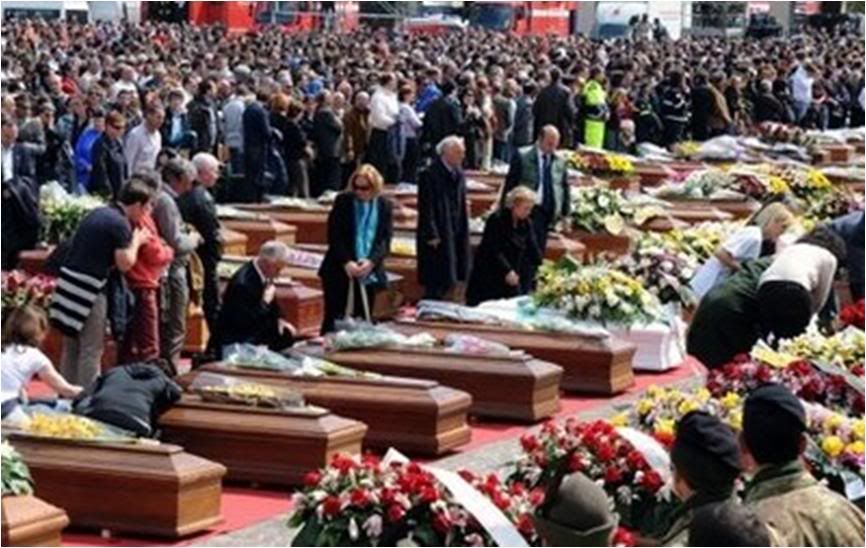
Two hundred fifty coffins - of 289 known deaths so far - laid down in four rows. This was the moving sight this morning at the Piazza D'Armi of the Italian Finance Guard's School for Inspectors at Coppito, near L'Aquila, at the state funeral for the victims of the recent earthquake.
Presiding at the rites in representation of Pope Benedict XVI was Cardinal Tarcisio Bertone, Secretary of State, who concelebrated with the Archbishop of L"Aquila, Mons Giuseppe Molinari, 18 other bishops from the stricken Abruzzo region and other regions of Italy, and the Pope's private secretary, Mons. Georg Gaenswein.
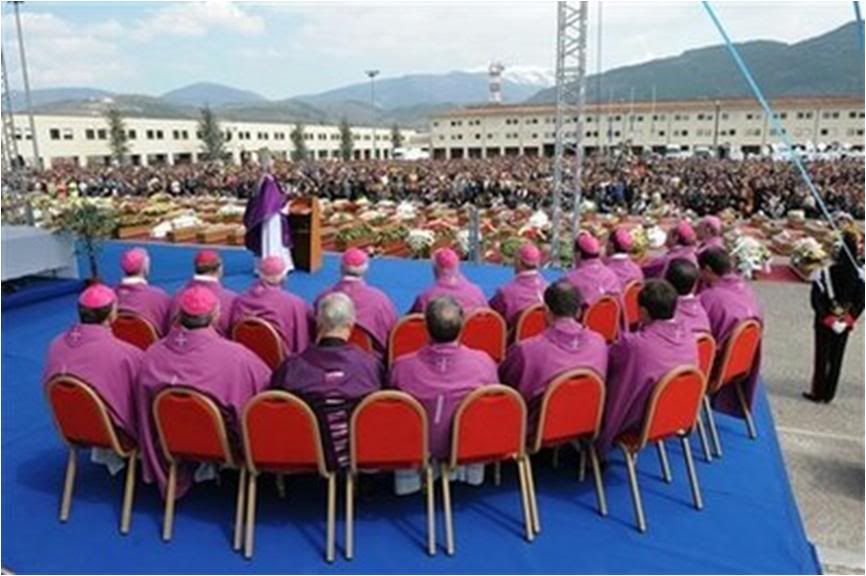
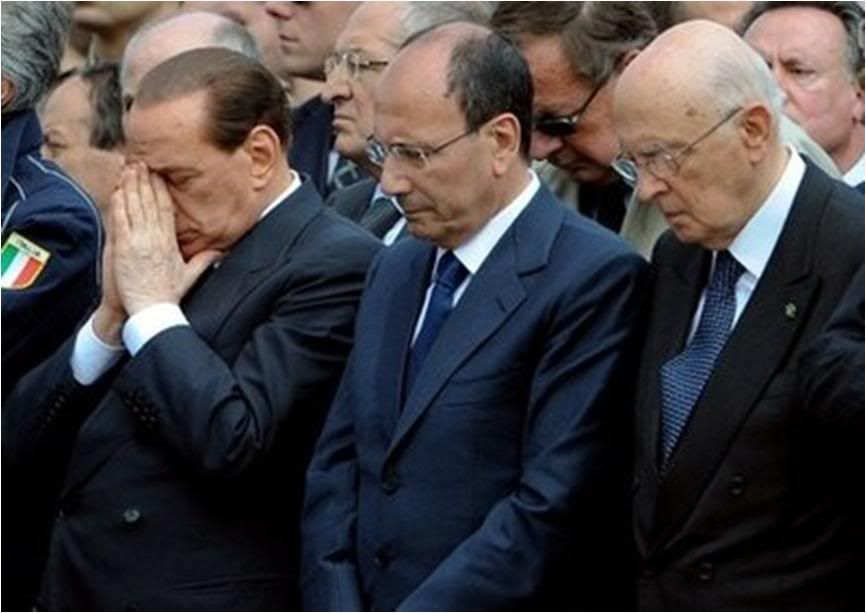
The highest Italian authorities were present, including the head of state, President Giorgio Napolitano, Prime Minister Silvio Berlusconi and the presidents of Italy's two chambers of Parliament.
Alessandro Carolis reports:
Two hours before the Mass began, the ceremony already had its icon of inconsolable grief - a mahogany coffin, lined up along the rest, upon which rested a small white one, a victim whose life was snuffed out too early.

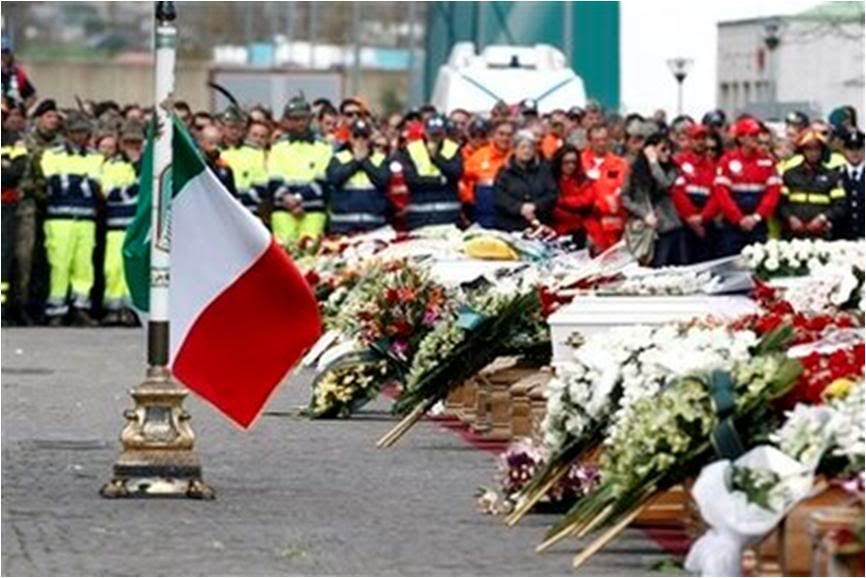
But it was not the only one of its kind. Another 4 little coffins were positioned that way, above or beside their mothers, a last contact instead of the embraces and caresses there would have been. But a killer quake at 3:32 in the morning of Monday has left ruin even in the hearts of those who survive.
Those five tiny coffins, more than anything, showed "the indecipherable enigma of dear', in the words of Cardinal Bertone, whom the Pope had sent along with his private secretary, in order to be near the living and the dead in this tragedy that has shaken not just Italy, whose grief the world shares.
Death is an enigma that signifies annihilation, 'an insuperable absence', except that the apparent 'silence of God' is the prelude, as Good Friday reminds us, to Resurrection, according to a message from Benedict XVI that was read by Mons. Gaenswein:
"At moments like these, faith remains the source of light and hope, especially during these days which speak of the suffering of the Son of God who became man for us: May his passion, his death and his resurrection, be for all a fountain of comfort, and open the heart of each one to the contemplation of that life when "there shall be no more death or mourning, wailing or pain, (for) the old order has passed away".
"I am sure that with the commitment of everyone, we can face the most impelling necessities," the Pope added, assuring the survivors that the Church, on every level, and in every way possible, will be with the institutions of the state on the front lines to assist them, just as 'the growing wave of solidarity' from rescue and aid teams has already shown.
Benedict XVI said he prays that everyone "may have the courage to continue in hope without yielding to despair".
Cardinal Bertone, in his homily, sought to accompany the grieving families' remembrance of their departed with great delicacy and respect.
He said that, just as it was to the Crucified Lord who felt abandoned on Calvary,
"God may seem absent, the pain may appear brutal and senseless, and the tears may obscure the timid rays of sunshine and spring. And yet, it is when we are provoked by the question, 'Where is your God now?', that we feel emerging from the depths the certainty of God's loving intervention."
In the silence of death, Cardinal Bertone said, the presence of God becomes 'a candle of hope'.
"Death makes us realize directly that in one instant everything can cease - dreams, plans, hopes. Everything ends, but love remains. God, who is love, remains. In this hour of profound sorrow and disorientation, the Word of God sustains our faith, comforts us, and assures us that nothing can annul the power of love."
The cardinal echoed the Pope's message in laying stress on the 'values of solidarity and brotherhood' which, he said, 'all of Italy', united to the victims of this tragedy, has once again shown it possesses in depth:
"Therefore, brothers and sisters, let us resume the journey, together with Mary, carrying together the pain of the insuperable absence of the departed, with a more assiduous, brotherly and loving presence among their families, who have become even more authentically our family, in the great family of the children of God.
"Thanks to the maternal assistance of Our Lady, let us try to draw from life an authentically Christian lesson of life. Supported by her intercession, we shall not fear the difficulties which lie before us".
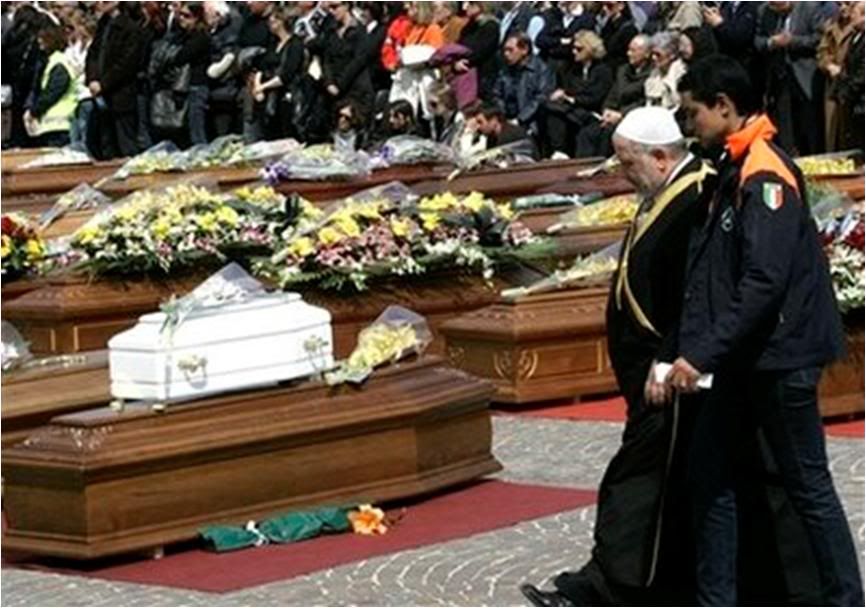
Those sentiments were echoed through a different religious sensibility by Imam Mohamed Nour Dacia, president of the Union of Islamic Communities, who offered prayers after the Mass for the six Muslims who died in the tragedy, and for all the other victims.
Beyond this sorrowful Good Friday is Easter, the glorious day of Resurrection, which, Cardinal Bertone wished, may bring comfort to all: "May Easter shine again from the ruins for a people who have so often been tried in your history."
Bishop Molinari gave the concluding words:
"Dear brothers and sisters, who have been struck by the loss of your dearest ones, it is a moment for great faith, as expressed to me by a father who lost two sons in this tragedy. A faith which is stronger than sorrow, than loss, than fear, doubt and despair... Lord, grant that from this insupportably absurd story of death may be born a new and luminous story of life and hope."
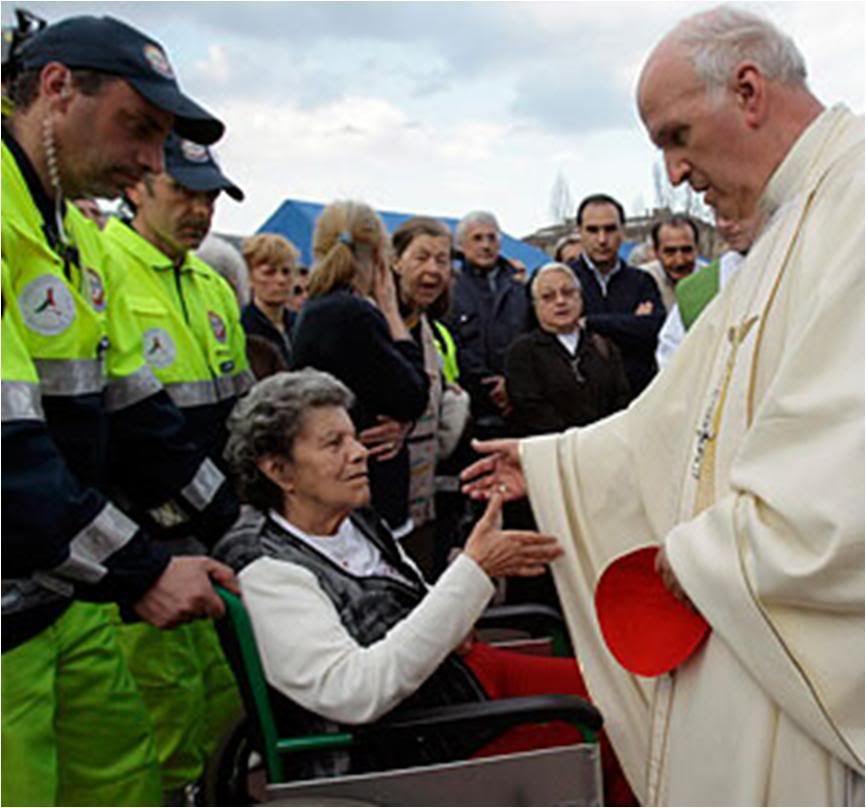
[Modificato da TERESA BENEDETTA 11/04/2009 01:54] |
 10/04/2009 19:49 10/04/2009 19:49 |
|
| | | OFFLINE | | Post: 17.105 | Registrato il: 28/08/2005
| Utente Gold | |
|

 CELEBRATION OF
CELEBRATION OF
THE PASSION OF THE LORD
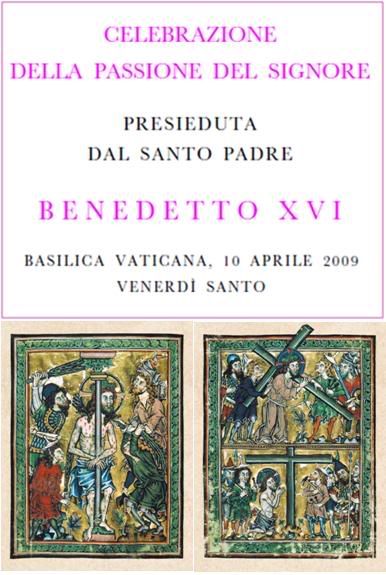 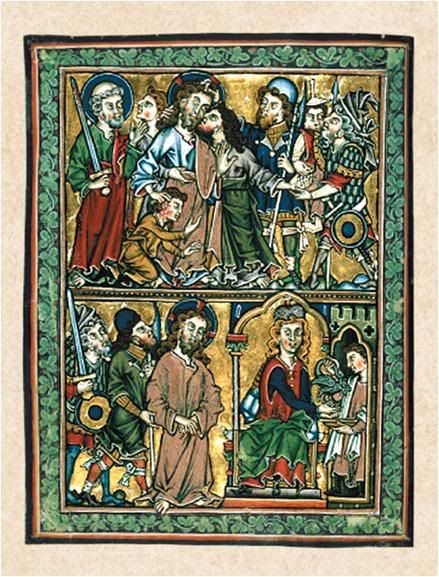 Libretto illustrations from the Cistercian Psaltery, MS 54, ca. 1260, Municipal Library of Besancon, France.
Libretto illustrations from the Cistercian Psaltery, MS 54, ca. 1260, Municipal Library of Besancon, France.
At 5 p.m. today, the Holy Father Benedict XVI, presided at the Good Friday celebration of the Passion of the Lord in St. Peter's Basilica.
The rites begain with the Liturgy of the Word, during which the Passion according to St. John was chanted, followed by a homily from Fr. Raniero Cantalamessa, Preacher of the Pontifical Household.
This was followed by universal prayers for various causes and the Adoration of the Cross. [NB: Since the Novus Ordo Missal was used, the prayer for the Jews is the version by Paul VI.]
The rites concluded with Communion.
LITURGY OF THE WORD
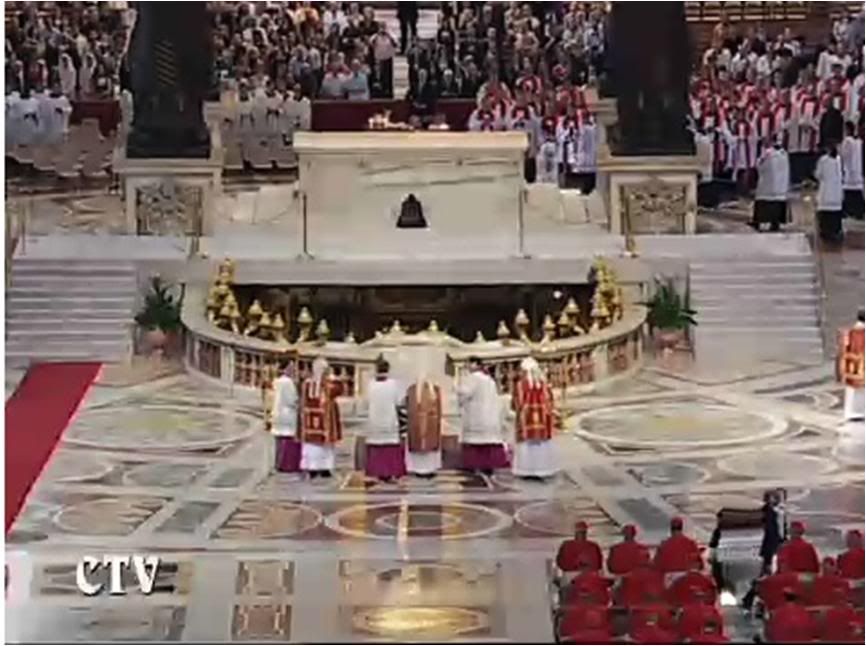
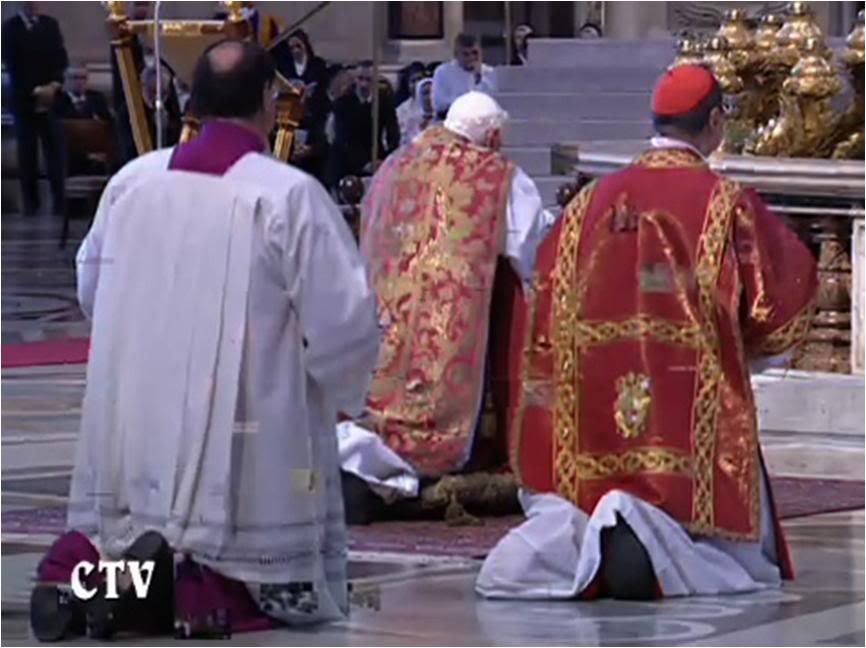
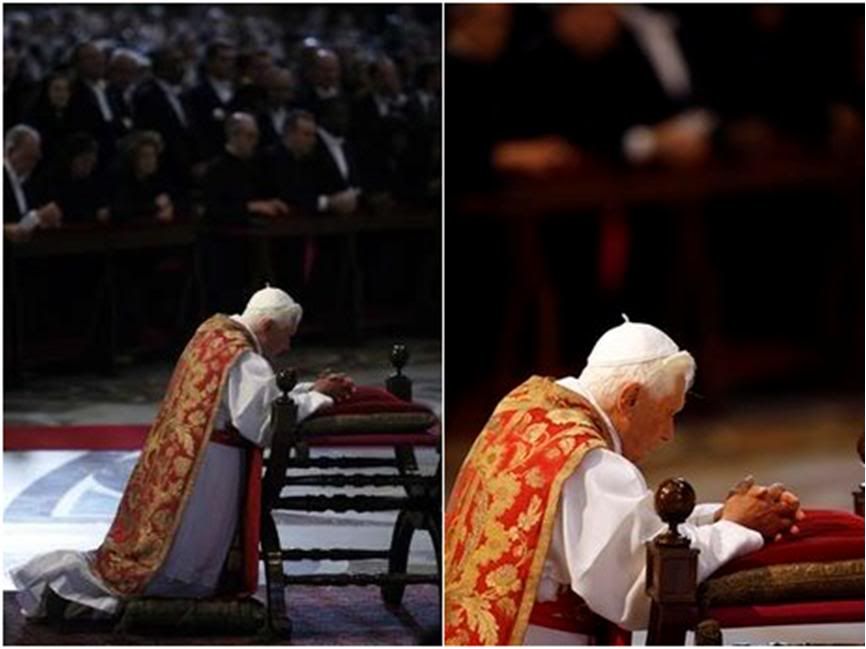 Acting as deacons for the Pope today were Cardinals Stanislaw Rylko and Giovanni Lajolo (left and right in the left photo below).
Acting as deacons for the Pope today were Cardinals Stanislaw Rylko and Giovanni Lajolo (left and right in the left photo below).
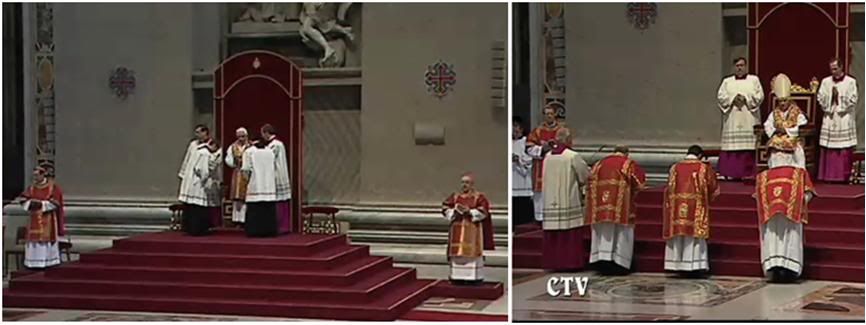

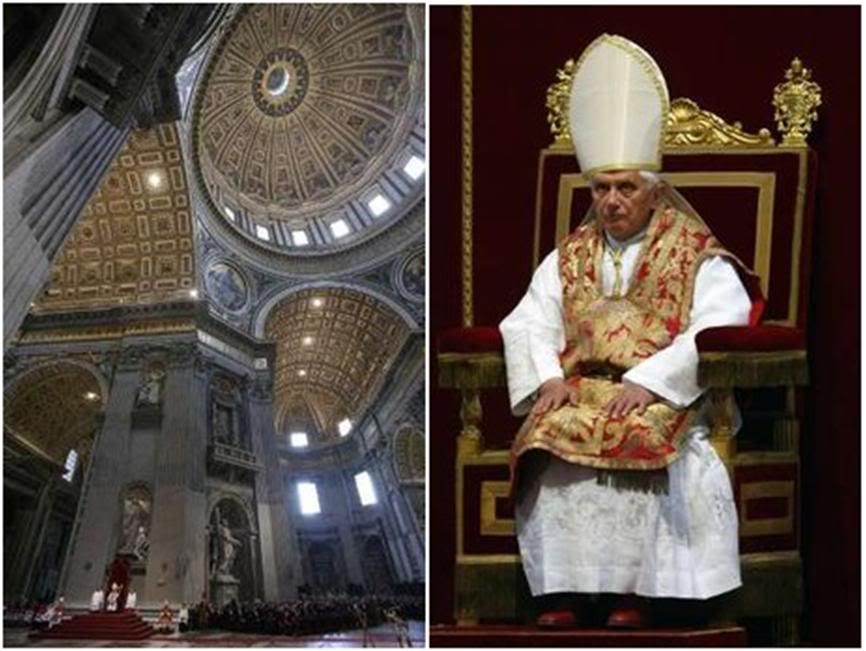
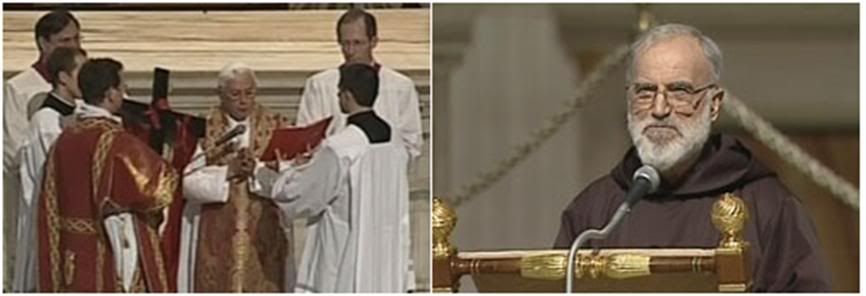

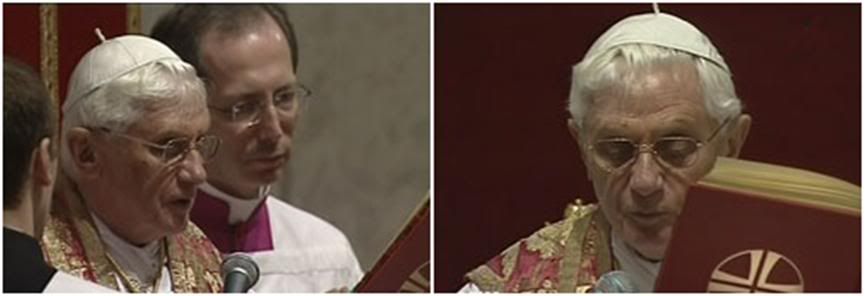
ADORATION OF THE CROSS
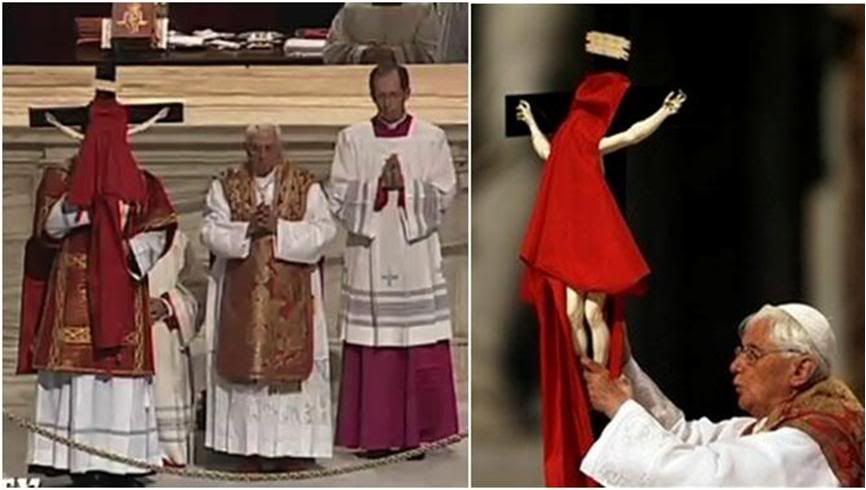
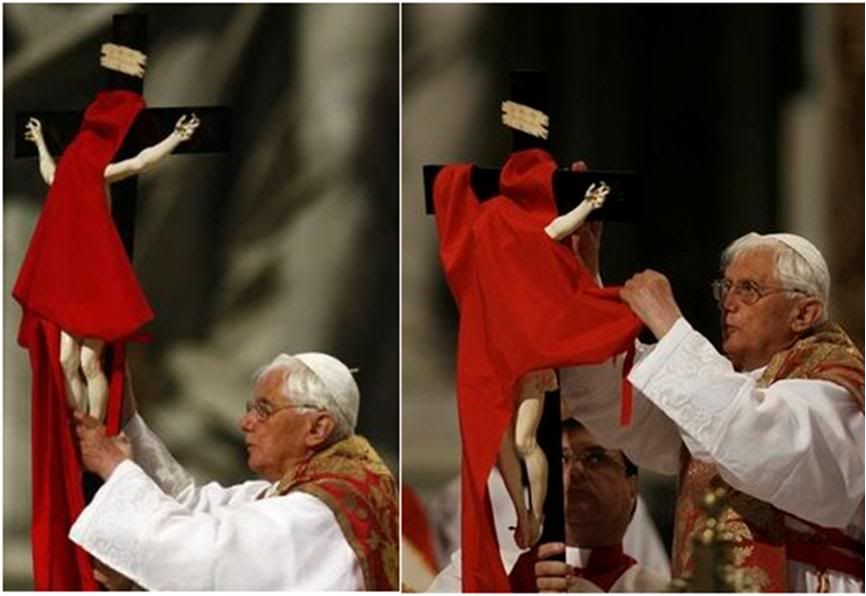
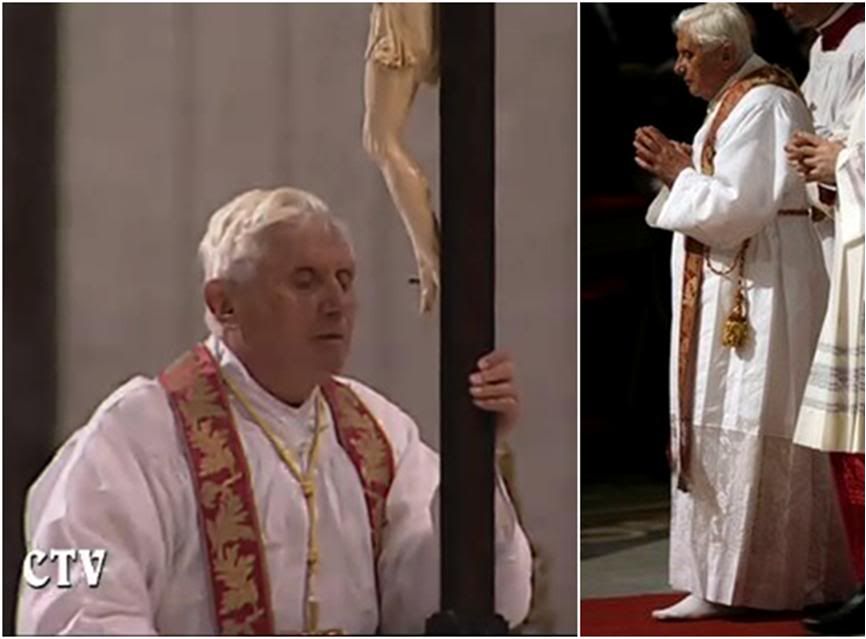
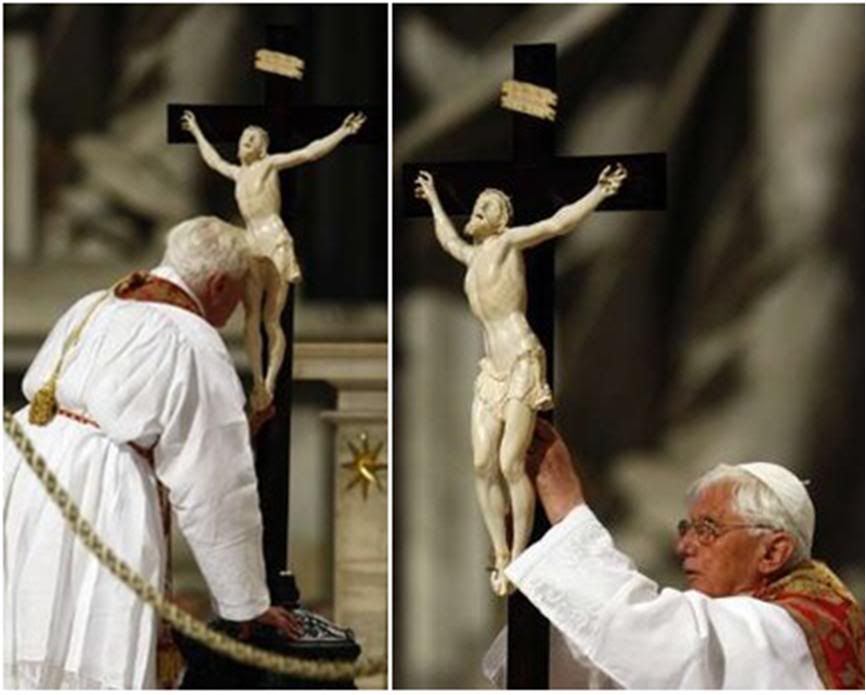
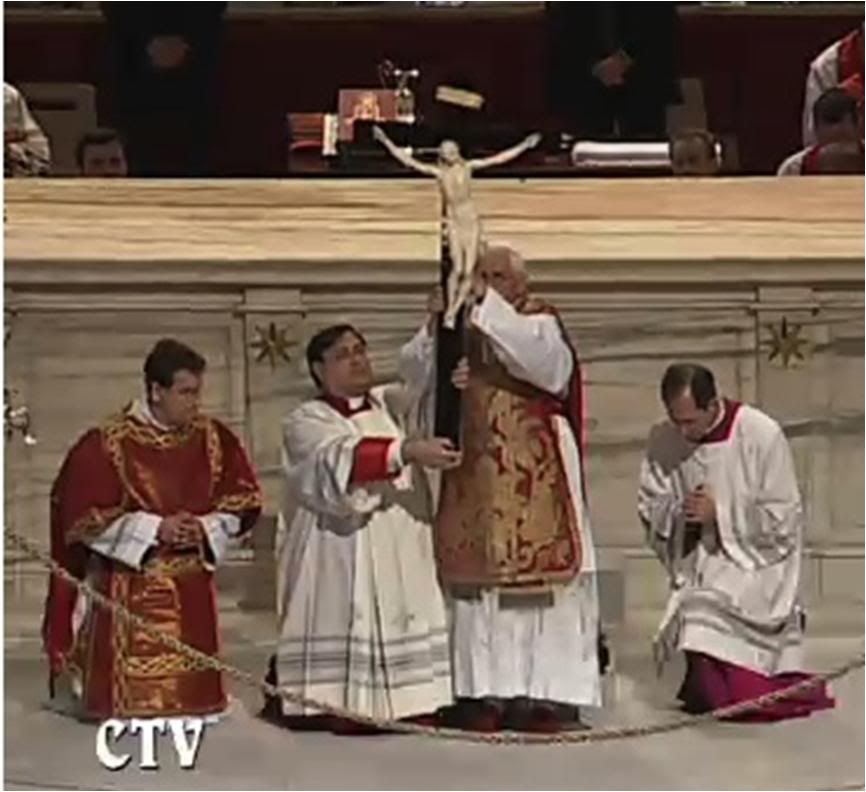
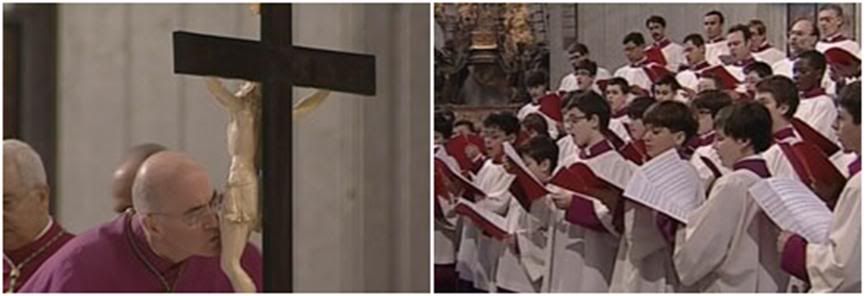
COMMUNION
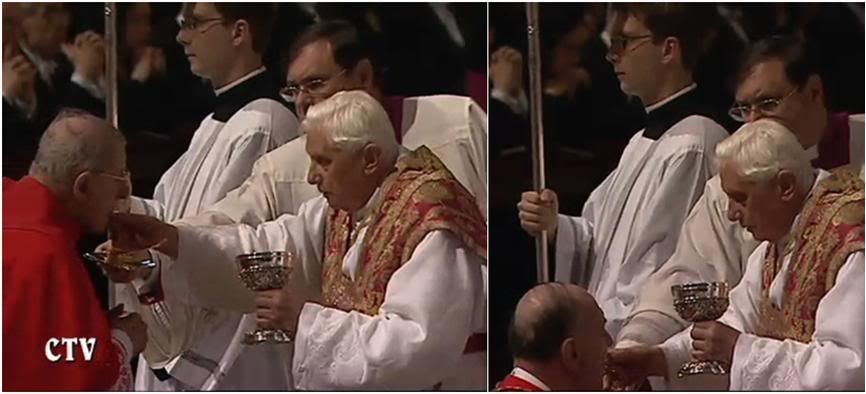
CTV video-caps by Shawn Tribe of

NB: Rather shocking was that most of the cardinals received communion from the Pope standing. You would think that in deference to him,
and on Good Friday, they might have honored his obviously preferred practice.
[Modificato da TERESA BENEDETTA 11/04/2009 03:19] |
 10/04/2009 23:55 10/04/2009 23:55 |
|
| | | OFFLINE | | Post: 17.106 | Registrato il: 28/08/2005
| Utente Gold | |
|

 VIA CRUCIS
VIA CRUCIS
AT THE COLOSSEUM
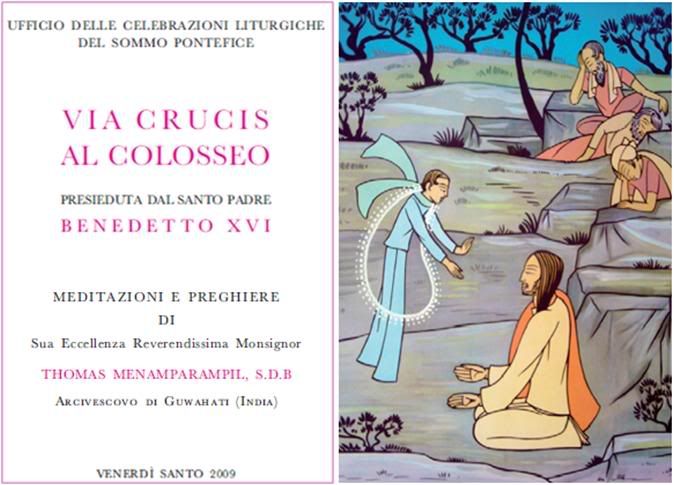
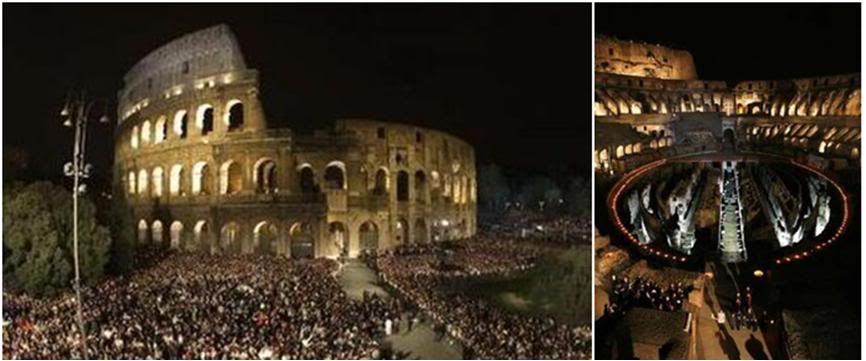
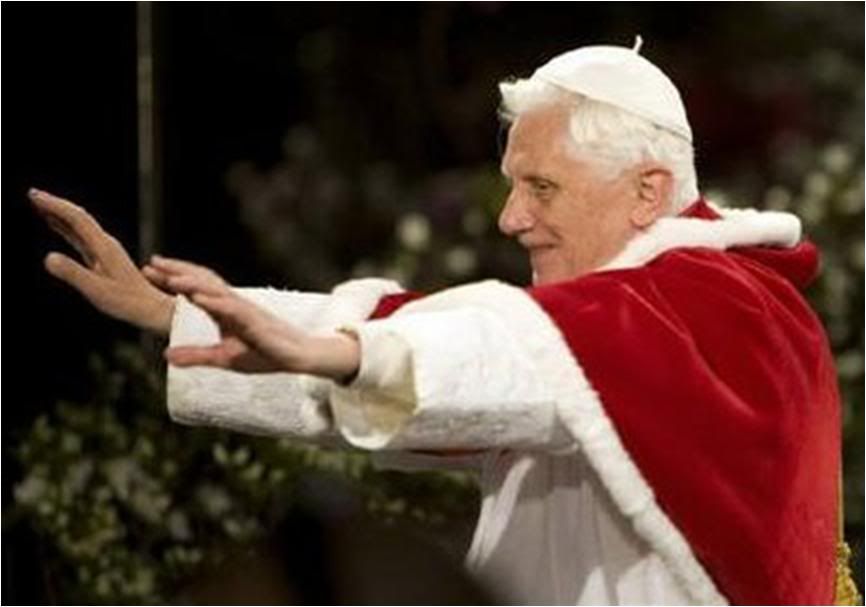
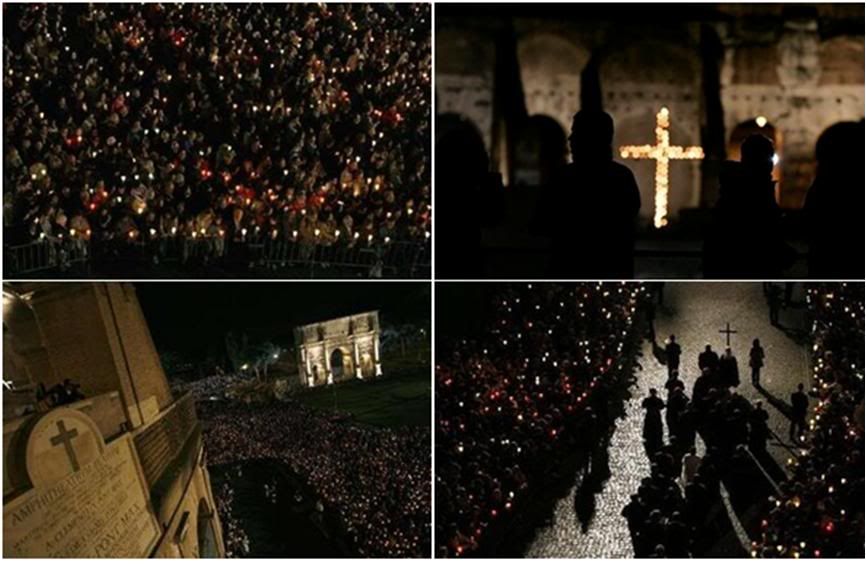 Pope presides over
Pope presides over
Way of the Cross procession
by FRANCES D'EMILIO

ROME, April 10 (AP) - Pope Benedict XVI presided over a torch-lit Way of the Cross procession at the Colosseum on Good Friday and said he was praying so that people who suffered losses in Italy's devastating quake can see the light of hope in their dark hour.
Tens of thousands of faithful, clutching prayer books and candles in paper lanterns, turned out for the traditional Holy Week appointment at the ancient Roman arena.
"Let us pray for all those who feel sorrow, above all for those suffering in the quake-stricken area of L'Aquila," Benedict urged, speaking at the end of the procession about the Apennine mountain town near the epicenter.
"Let us pray that the star of hope appears to them in this dark night," he said.
Suffering and hope were the motif of the meditations read aloud as faithful carried the slender, lightweight cross in the shadows cast by the Colosseum's massive stones.
Benedict told the faithful they had come to "sing together a hymn of hope. We want to tell ourselves that all is not lost in moments of difficulty."
Benedict, who turns 82 next week, wore a crimson-colored, ermine-trimmed cape against the cool night air. Kneeling on a terrace overlooking the Colosseum, he folded his hands in prayer and bowed his head in reflection.
The ritual commemorates Jesus's suffering in the hours before his crucifixion and his death on the cross.
Jesus's face is "reflected in that of every person who is humiliated and offended, sick and suffering, alone, abandoned and despised," Benedict said.
Through his suffering, Jesus has "broken the solitude of our tears, he has entered our every grief and our every anxiety," the Pope said in remarks at the end of the 90-minute long procession.
Among those holding the cross were a young man in a wheelchair and a mother flanked by her family.
A candlelit cross atop one of the monument's stone tiers twinkled in the night.
Earlier in the day, Benedict sent a message to survivors at a mass funeral for many of those who perished in Monday's earthquake, urging them to continue to hope amid their sorrow.
The 6.3 magnitude quake struck near the Apennine mountain town of L'Aquila as people slept, toppling apartment houses, collapsing churches and leaving many other building severely damaged. At least 290 people perished, more than 1,000 were injured and 40,000 were left homeless.
Holy Week ceremonies culminate in Easter Sunday Mass in St. Peter's Square. On Saturday night, the Pope will celebrate an Easter vigil Mass in St. Peter's Basilica.
Cardinal Agostino Vallini, the Pope's Vicar in Rome, hands over the Cross to the Holy Father for the last Station, after which the Pope addressed the faithful.
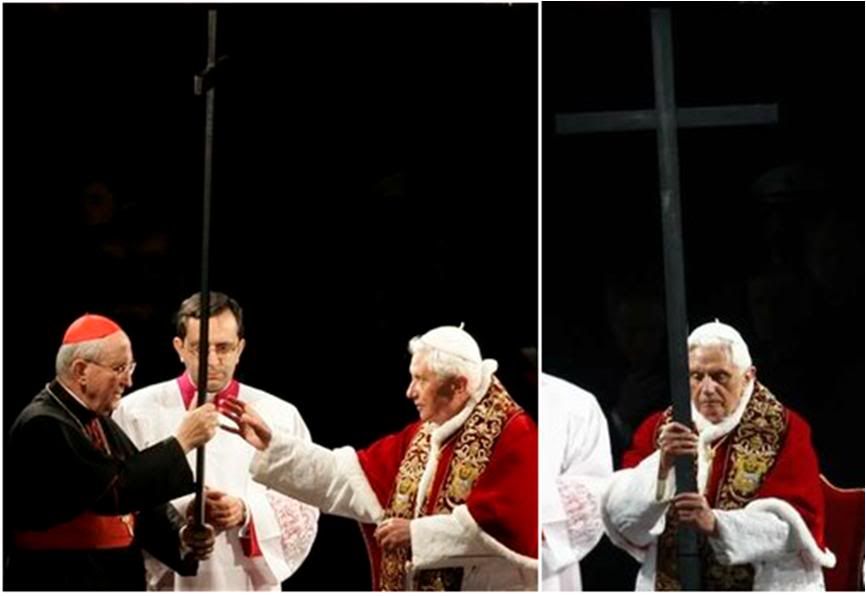
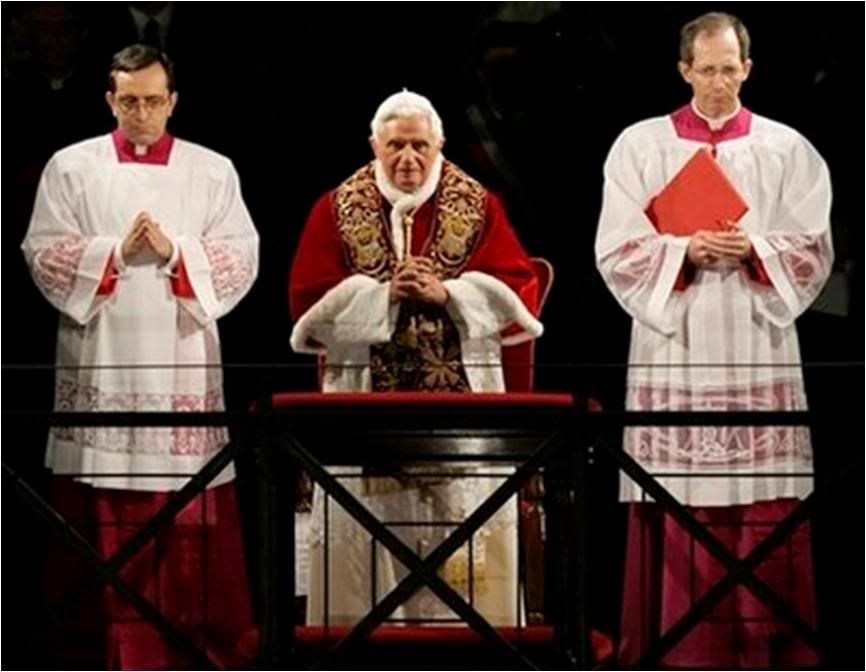
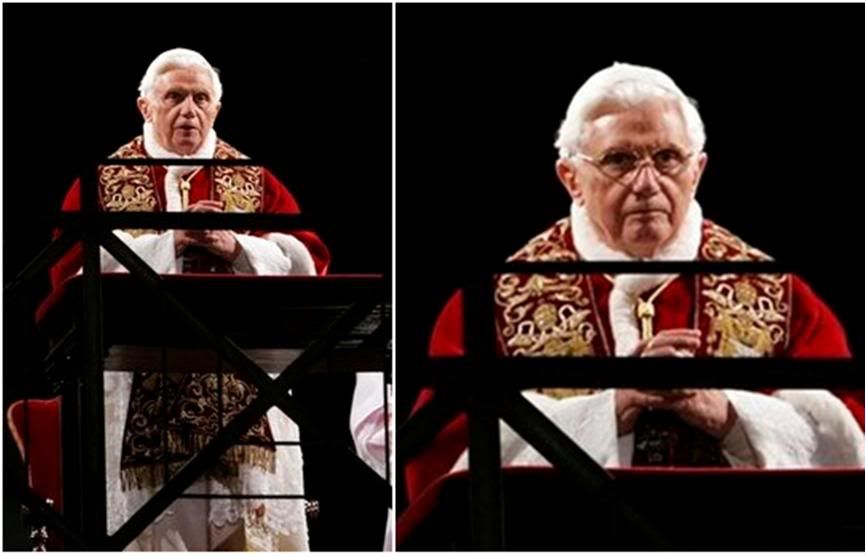

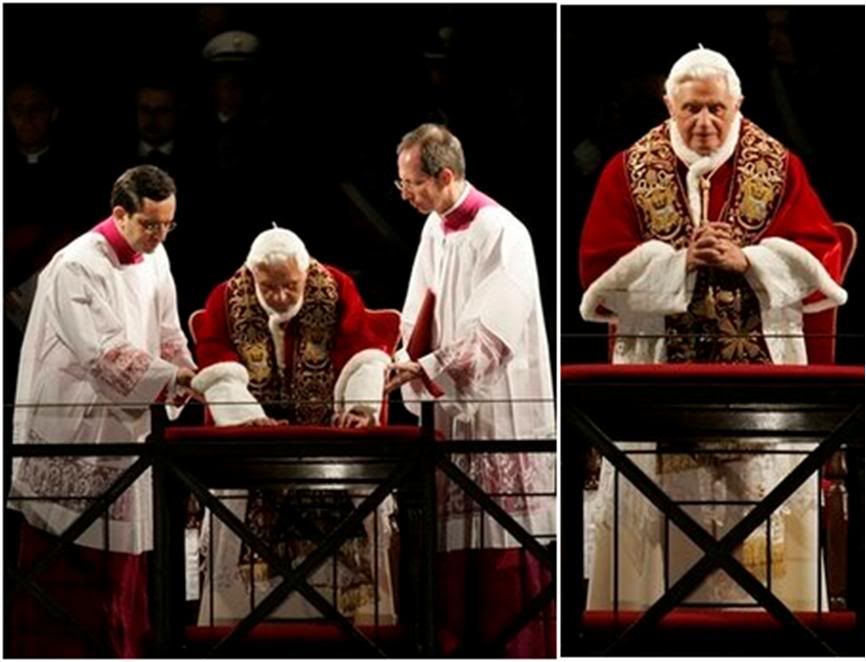
ADDRESS OF THE HOLY FATHER
AT THE CONCLUSION OF
THE VIA CRUCIS
Official Vatican translation
from the English service of

Dear Brothers and Sisters,
At the end of his dramatic Passion narrative, the Evangelist Saint Mark tells us: “The centurion, who stood facing him, saw that he thus breathed his last, and said: ‘Truly this man was the Son of God!’” (Mk 15:39).
We cannot fail to be surprised by the profession of faith of this Roman soldier, who had been present throughout the various phases of the Crucifixion.
When the darkness of night was falling on that Friday so unlike any other in history, when the sacrifice of the Cross was already consummated and the bystanders were making haste to celebrate the Jewish Passover in the usual way, these few words, wrung from the lips of a nameless commander in the Roman army, resounded through the silence that surrounded that most singular death.
This Roman army officer, having witnessed the execution of one of countless condemned prisoners, was able to recognize in this crucified man the Son of God, who had perished in the most humiliating abandonment.
His shameful end ought to have marked the definitive triumph of hatred and death over love and life. But it was not so!
Hanging from the Cross on Golgotha was a man who was already dead, but that man was acknowledged to be the “Son of God” by the centurion, “on seeing that he thus breathed his last”, as the Evangelist specifies.
We are reminded of this soldier’s profession of faith every time we listen anew to Saint Mark’s Passion account. This evening, like the centurion, we pause to gaze on the lifeless face of the Crucified One at the conclusion of this traditional Via Crucis which, through radio and television coverage, has brought many people together from every part of the world.
We have re-lived the tragic event of a man unique in the history of all times, who changed the world not by killing others but by letting himself be killed as he hung from a cross.
This man, seemingly one of us, who while he was being killed forgave his executioners, is the “Son of God”, who, as the Apostle Paul reminds us, “did not count equality with God a thing to be grasped, but emptied himself, taking the form of a servant … he humbled himself, and became obedient unto death, even death on a cross” (Phil 2:7-8).
The anguish of the Passion of the Lord Jesus cannot fail to move to pity even the most hardened hearts, as it constitutes the climax of the revelation of God’s love for each of us.
Saint John observes: “God so loved the world that he gave his only Son, that whoever believes in him should not perish, but have eternal life” (Jn 3:16). It is for love of us that Christ dies on the cross!
Throughout the course of the millennia, a great multitude of men and women have been drawn deeply into this mystery and they have followed him, making in their turn, like him and with his help, a gift to others of their own lives. They are the saints and the martyrs, many of whom remain unknown to us.
Even in our own time, how many people, in the silence of their daily lives, unite their sufferings with those of the Crucified One and become apostles of a true spiritual and social renewal!
What would man be without Christ? Saint Augustine observes: “You would still be in a state of wretchedness, had He not shown you mercy. You would not have returned to life, had He not shared your death. You would have passed away had He not come to your aid. You would be lost, had He not come” (Discourse 185:1). So why not welcome him into our lives?
Let us pause this evening to contemplate his disfigured face: it is the face of the Man of sorrows, who took upon himself the burden of all our mortal anguish.
His face is reflected in that of every person who is humiliated and offended, sick and suffering, alone, abandoned and despised. Pouring out his blood, he has rescued us from the slavery of death, he has broken the solitude of our tears, he has entered into our every grief and our every anxiety.
Brothers and Sisters! As the Cross rises up on Golgotha, the eyes of our faith are already turned towards the dawning of the new Day, and we begin to taste the joy and splendour of Easter.
“If we have died with Christ”, writes Saint Paul, “we believe that we shall also live with Him” (Rom 6:8).
In this certainty, let us continue our journey. Tomorrow, on Holy Saturday, we will watch and pray together with Mary, the Sorrowful Virgin, preparing ourselves in this way to celebrate the wonder of the Lord’s resurrection at the solemn Easter Vigil.
I wish all of you, even now, a Happy Easter in the light of the Risen Lord!

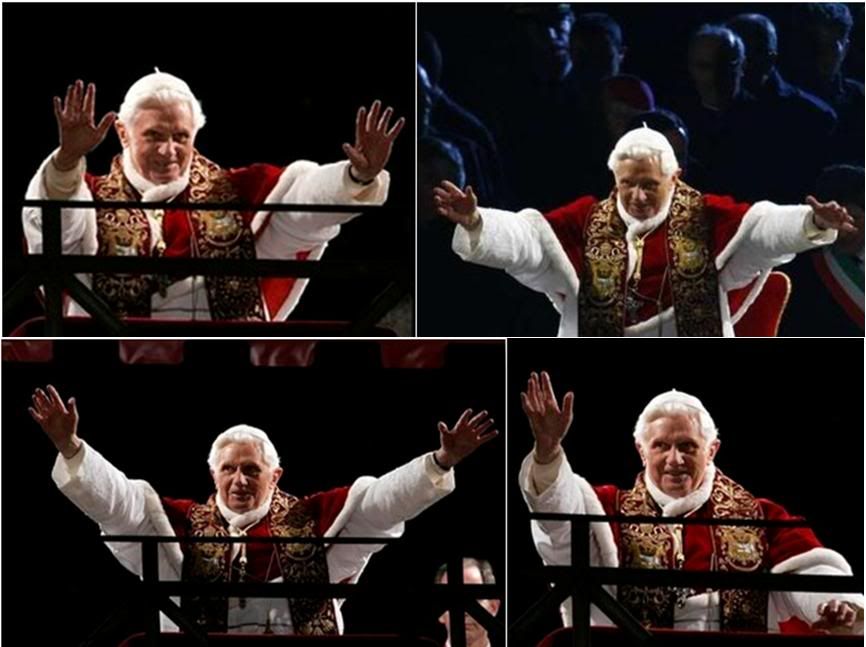 Privately, I label the above montage 'THE ARCHANGEL JOSEPH-BENEDICT'.
Privately, I label the above montage 'THE ARCHANGEL JOSEPH-BENEDICT'.
[Modificato da TERESA BENEDETTA 13/04/2009 12:44] |
 11/04/2009 01:50 11/04/2009 01:50 |
|
| | | OFFLINE | | Post: 17.107 | Registrato il: 28/08/2005
| Utente Gold | |
|
FOR AN AMAZING COLLECTION OF PHOTOGRAPHS FROM THE HOLY THURSDAY AND GOOD FRIDAY LITURGIES,
SEE GLORIA'S PHOTOGALLERY ON
benedettoxviforum.freeforumzone.leonardo.it/discussione.aspx?idd=8281...
[Modificato da TERESA BENEDETTA 11/04/2009 01:50] |
 11/04/2009 07:10 11/04/2009 07:10 |
|
| | | OFFLINE | | Post: 17.108 | Registrato il: 28/08/2005
| Utente Gold | |
|

An excerpt from
God and the World:
A Conversation with Peter Seewald
by Joseph Cardinal Ratzinger.
Ignatius Press, 2002.
 Lord knows the simplest, shortest homily from Benedict XVI is enough food for thought to feast on for days, let alone the bumper harvest of homilies and catecheses he has given us in the past few weeks - or just this week alone.
Lord knows the simplest, shortest homily from Benedict XVI is enough food for thought to feast on for days, let alone the bumper harvest of homilies and catecheses he has given us in the past few weeks - or just this week alone.
But this excerpt is a good refresher and appropriate for Good Friday-Holy Saturday meditation.

SEEWALD: We are used to thinking of suffering as something we try to avoid at all costs. And there is nothing that many societies get more angry about than the Christian idea that one should bear with pain, should endure suffering, should even sometimes give oneself up to it, in order thereby to overcome it. "Suffering", John Paul II believes, "is a part of the mystery of being human." Why is this?
CARDINAL RATZINGER: Today what people have in view is eliminating suffering from the world. For the individual, that means avoiding pain and suffering in whatever way. Yet we must also see that it is in this very way that the world becomes very hard and very cold. Pain is part of being human.
Anyone who really wanted to get rid of suffering would have to get rid of love before anything else, because there can be no love without suffering, because it always demands an element of self-sacrifice, because, given temperamental differences and the drama of situations, it will always bring with it renunciation and pain.
When we know that the way of love – this exodus, this going out of oneself – is the true way by which man becomes human, then we also
understand that suffering is the process through which we mature.
Anyone who has inwardly accepted suffering becomes more mature and more understanding of others, becomes more human. Anyone who has consistently avoided suffering does not understand other people; he becomes hard and selfish.
Love itself is a passion, something we endure. In love experience first a happiness, a general feeling of happiness.
Yet on the other hand, I am taken out of my comfortable tranquility and have to let myself be reshaped. If we say that suffering is the inner side of love, we then also understand it is so important to learn how to suffer–and why, conversely, the avoidance of suffering renders someone unfit to cope with life.
He would be left with an existential emptiness, which could then only be combined with bitterness, with rejection and no longer with any inner acceptance or progress toward maturity.
What would actually have happened if Christ had not appeared and if he had not died on the tree of the Cross? Would the world long since have come to ruin without him?
That we cannot say. Yet we can say that man would have no access to God. He would then only be able to relate to God in occasional fragmentary attempts. And, in the end, he would not know who or what God actually is.
Something of the light of God shines through in the great religions of the world, of course, and yet they remain a matter of fragments and questions.
But if the question about God finds no answer, if the road to him is blocked, if there is no forgiveness, which can only come with the authority of God himself, then human life is nothing but a meaningless experiment.
Thus, God himself has parted the clouds at a certain point. He has turned on the light and has shown us the way that is the truth, that makes it possible for us to live and that is life itself.
Someone like Jesus inevitably attracts an enormous amount of attention and would be bound to offend any society. At the time of his appearance, the prophet from Nazareth was not only cheered, but also mocked and persecuted. The representatives of the established order saw in Jesus's teaching and his person a serious threat to their power, and Pharisees and high priests began to seek to take his life.
At the same time, the Passion was obviously part and parcel of his message, since Christ himself began to prepare his disciples for his suffering and death. In two days, he declared at the beginning of the feast of Passover, "the Son of Man will be betrayed and crucified."
Jesus is adjusting the ideas of the disciples to the fact that the Messiah is not appearing as the Savior or the glorious powerful hero to restore the renown of Israel as a powerful state, as of old. He doesn't even call himself Messiah, but Son of Man.
His way, quite to the contrary, lies in powerlessness and in suffering death, betrayed to the heathen, as he says, and brought by the heathen to the Cross. The disciples would have to learn that the kingdom of God comes into the world in that way, and in no other.
A world-famous picture by Leonardo da Vinci, the Last Supper, shows Jesus's farewell meal in the circle of his twelve apostles. On that evening, Jesus first of all throws them all into terror and confusion by indicating that he will be the victim of betrayal.
After that he founds the holy Eucharist, which from that point onward has been performed by Christians day after day for two thousand years.
"During the meal," we read in the Gospel, "Jesus took the bread and spoke the blessing; then he broke the bread, shared it with the disciples, and said: Take and eat; this is my body. Then he took the cup, spoke the thanksgiving, and passed it to the disciples with the words: Drink of this, all of you; this is my blood, the blood of the New Covenant, which is shed for you and for many for the forgiveness of sins. Do this in remembrance of me."
These are presumably the sentences that have been most often pronounced in the entire history of the world up till now. They give the impression of a sacred formula.
They are a sacred formula. In any case, these are words that entirely fail to fit into any category of what would be usual, what could be expected or premeditated. They are enormously rich in meaning and enormously profound.
If you want to get to know Christ, you can get to know him best by meditating on these words, and by getting to know the context of these words, which have become a sacrament, by joining in the celebration. The institution of the Eucharist represents the sum total of what Christ Is.
Here Jesus takes up the essential threads of the Old Testament. Thereby he relies on the institution of the Old Covenant, on Sinai, on one hand, thus making clear that what was begun on Sinai is now enacted anew: The Covenant that God made with men is now truly perfected.
The Last Supper is the rite of institution of the New Covenant. In giving himself over to men, he creates a community of blood between God and man.
On the other hand, some words of the prophet Jeremiah are taken up here, proclaiming the New Covenant. Both strands of the Old Testament (Law and prophets) are amalgamated to create this unity and, at the same time, shaped into a sacramental action. The Cross is already anticipated in this.
For when Christ gives his Body and his Blood, gives himself, then this assumes that he is really giving up his life. In that sense, these words are the inner act of the Cross, which occurs when God transforms this external violence against him into an act of self-donation to mankind.
And something else is anticipated here, the Resurrection. You cannot give anyone dead flesh, dead body to eat. Only because he is going to rise again are his Body and his Blood new. It is no longer cannibalism but union with the living, risen Christ that is happening here.
In these few words, as we see, lies a synthesis of the history of religion — of the history of Israel's faith, as well as of Jesus's own being and work, which finally becomes a sacrament and an abiding presence. ...
The soldiers abuse Jesus in a way we can hardly imagine. All hatred, everything bestial in man, utterly abysmal, the most horrible things men can do to one another, is obviously unloaded onto this man.
Jesus stands for all victims of brute force. In the twentieth century itself we have seen again how inventive human cruelty can be; how cruelty, in the act of destroying the image of man in others, dishonors and destroys that image in itself.
The fact that the Son of God took all this upon himself in exemplary manner, as the "Lamb of God", is bound to make us shudder at the cruelty of man, on one hand, and make us think carefully about ourselves, how far we are willing to stand by as cowardly or silent onlookers, or how far we share responsibility ourselves.
On the other side, it is bound to transform us and to make us rejoice in God. He has put himself on the side of the innocent and the suffering and would like to see us standing there too.
 My outrage at all the unfairness, injustice and even outright hatred directed against the Pope has always been alleviated by the thought that Joseph Ratzinger/Benedict XVI has borne - and continues to bear - all the 'slings and arrows of outrgaeous fortune' hurled at him all this years because he sees it as the cross he has to bear and gladly does in genuine imitation of Christ.
My outrage at all the unfairness, injustice and even outright hatred directed against the Pope has always been alleviated by the thought that Joseph Ratzinger/Benedict XVI has borne - and continues to bear - all the 'slings and arrows of outrgaeous fortune' hurled at him all this years because he sees it as the cross he has to bear and gladly does in genuine imitation of Christ.
And when one thinks of all that a Pope must do - and be - not only for all Christians but for all mankind, then one realizes how much he is the Vicar of Christ in every way, including carrying the weight of the world....infinitely more complicated now than it was in the days of Leo the Great or Gregory the Great....
[Modificato da TERESA BENEDETTA 11/04/2009 15:06] |
 11/04/2009 16:09 11/04/2009 16:09 |
|
| | | OFFLINE | | Post: 17.110 | Registrato il: 28/08/2005
| Utente Gold | |
|

April 11
Saturday in Holy Week
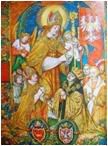 St. Stanislaus of Cracow(1030-1079)
St. Stanislaus of Cracow(1030-1079)
Bishop and Martyr
Patron Saint of Poland
OR today.
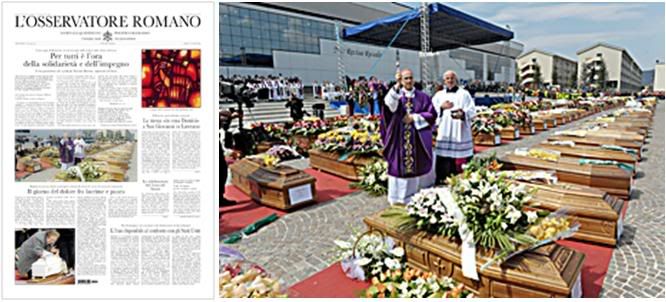
Benedict XVI's message at the funeral rites for Italy's earthquake victims:
'For everyone, it's a time for solidarity and commitment'

The OR devoted much of the front page today to remembering the victims of the earthquake that centered in L'Aquila.
It also has he text of the Holy Father's homily at the Mass of the Lord's Supper on Thursday and an anticipation of
the Good Friday papal liturgies, which both took place after the newspaper's afternoon press run. And there's
a Page 1 item on Iran's readiness to talk to the United States which was already reported two days ago, plus,
coming from Ahmadinejad, what does it have to do with reality?
EASTER WEEKEND
PAPAL LITURGIES

April 11-12
EASTER VIGIL & MASS, April 11-12
Cappella Papale
21:00 St. Peter's Basilica
The Holy Father will bless the new flame in the atrium of the Basilica. After the processional entry
into the basilica with the Paschal candle and the chanting of the Exsultat, he will preside at the Liturgy
of the Word, the Baptismal Liturgy, and the Eucharistic Liturgy which will be concelebrated
with the cardinals present.
EASTER SUNDAY MASS
10:15 St. Peter's Square
The Holy Father will celebrate the Mass.
Afterwards, he will impart his blessing Urbi et Orbi from the central loggia of St. Peter's Basilica.
[Modificato da TERESA BENEDETTA 11/04/2009 16:11] |
 11/04/2009 22:21 11/04/2009 22:21 |
|
| | | OFFLINE | | Post: 17.114 | Registrato il: 28/08/2005
| Utente Gold | |
|
 EASTER VIGIL MASS
EASTER VIGIL MASS
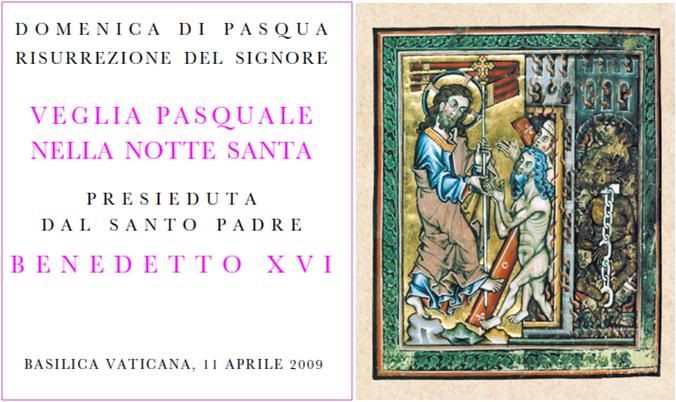
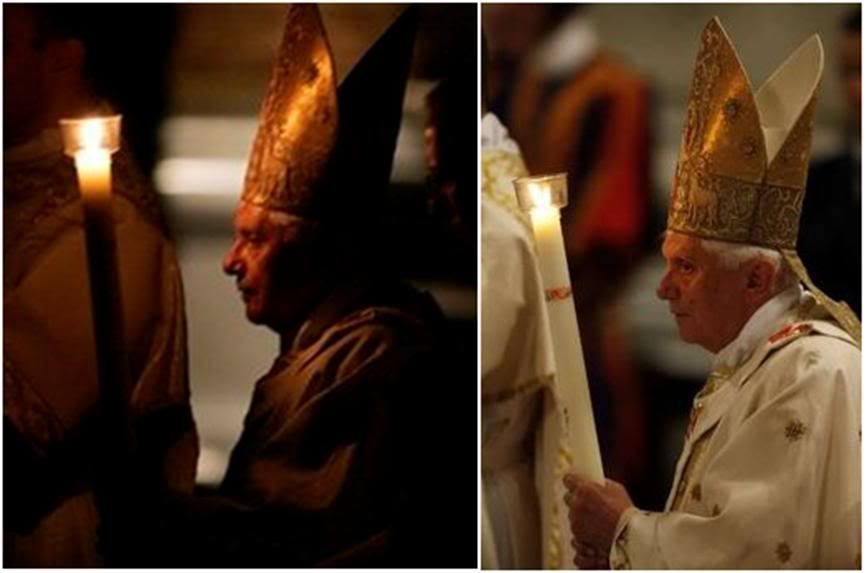
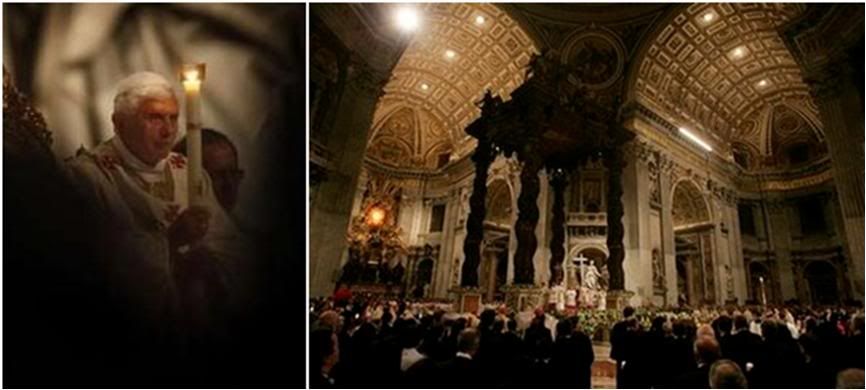
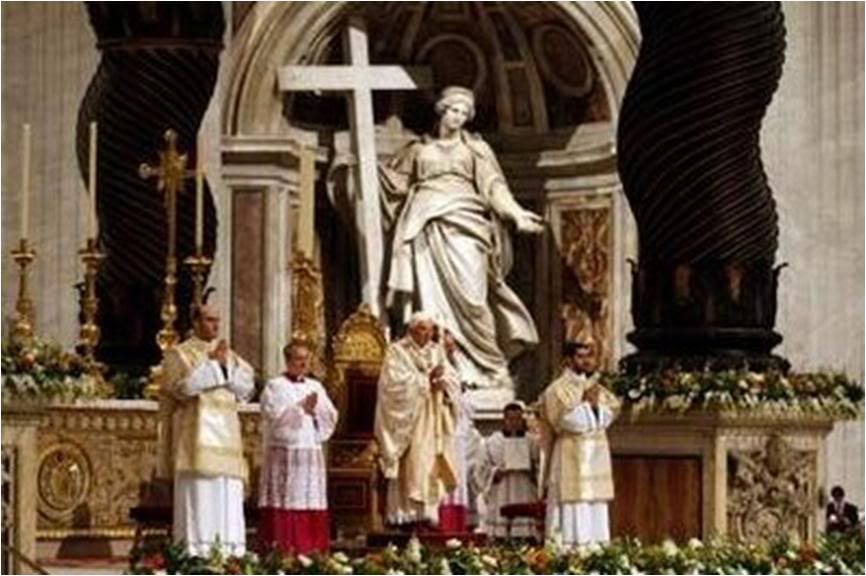
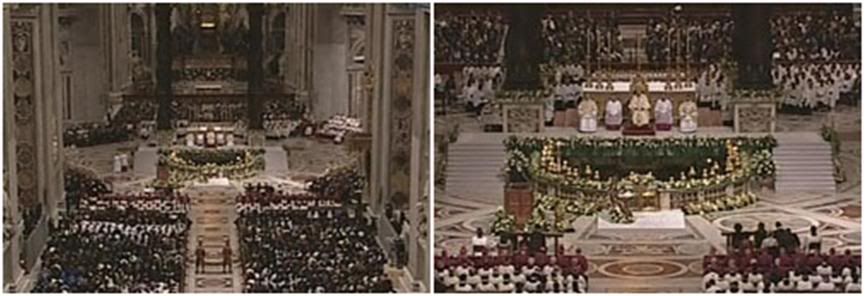 Pope Benedict XVI leads Easter vigil
Pope Benedict XVI leads Easter vigil

VATICAN CITY, April 11 (dpa) - Pope Benedict XVI led the traditional Easter vigil late Saturday, entering a darkened St Peter's Basilica while carrying a tall candle - a gesture symbolizing the Christian belief in the resurrected Jesus' illuminating presence in the world.
Taking their cue from the 81-year-old pontiff, thousands of faithful gathered inside lit their own candles, the flames flickering inside the church's immense interior.
Outside, on a mild, spring night in Rome, tens of thousands more followed the ceremony from four giant screens erected on St Peter's Square.
During the ceremony Benedict also administered the sacraments of baptism, confirmation and first communion to five converts - three women and two men - including nationals from China, Italy and the US.
In his homily Benedict said that through Jesus'S resurrection mankind can hope for eternal life, but that this is something that can only be achieved by first experiencing death.
"The Easter candle burns, and is thereby consumed: Cross and resurrection are inseperable," the pontiff said referring to Jesus' crucifixion.
"From the cross, from the son's self-giving, light is born, true radiance comes into the world," Benedict said.
This year's Easter festivities in Italy have been tinged with sorrow for the victims of a devastating earthquake that struck the country's central Abruzzo region on Monday.
By Saturday the death toll stood at 291, including at least 20 children.
During a Friday evening Way-of-the-Cross procession over which he presided, Benedict renewed his condolences for the dead, offering prayers that their souls may rest in peace.
Earlier in the week, the German-born pontiff said he planned to visit the region hit by the tremor "as soon as possible."
Some 17,000 people evacuated from L'Aquila and other badly damaged towns have spent their nights in several tent shelters set up by authorities.
Benedict has donated 500 chocolate Easter eggs to be distributed to children staying in the tent shelters, the Vatican said. [According to the Italian news agencies, he also donated cash to be distributed to those who need it to get by until things can return to normal.]
Benedict is scheduled to celebrate Easter Mass on Sunday in St Peter's Square. He will also impart his traditional Urbi et Orbi "to the city and to the world" blessing and message.
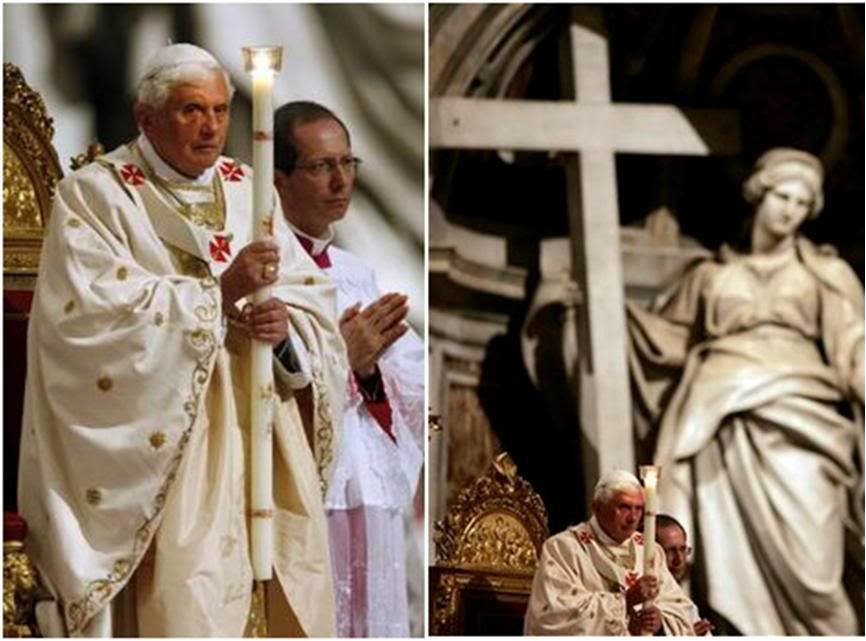
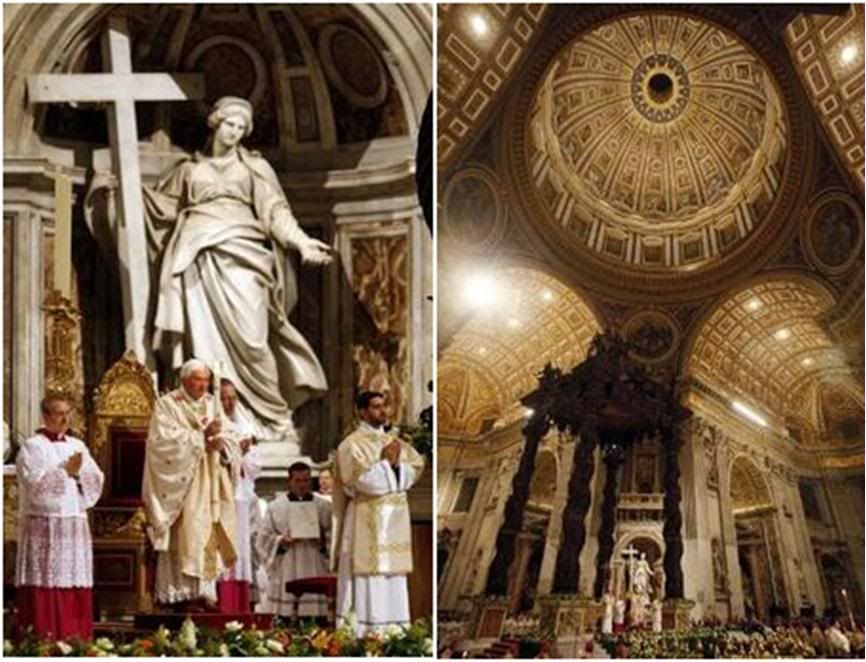
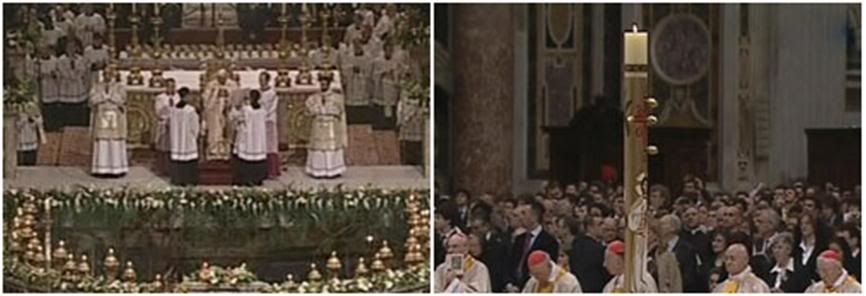


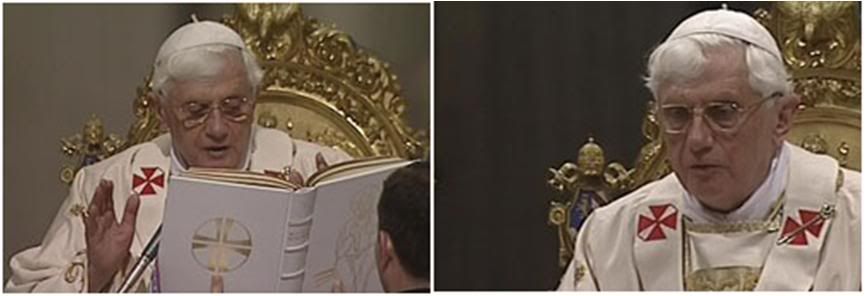 Herei's the official translation of the Pope's homily tonight,
Herei's the official translation of the Pope's homily tonight,
from the English service of

THE HOLY FATHER'S HOMILY
Dear Brothers and Sisters,
Saint Mark tells us in his Gospel that as the disciples came down from the Mount of the Transfiguration, they were discussing among themselves what “rising from the dead” could mean (cf. Mk 9:10).
A little earlier, the Lord had foretold his passion and his Resurrection after three days. Peter had protested against this prediction of death. But now, hey were wondering what could be meant by the word “resurrection”.
Could it be that we find ourselves in a similar situation? Christmas, the birth of the divine Infant, we can somehow immediately comprehend. We can love the child, we can imagine that night in Bethlehem, Mary’s joy, the joy of Saint Joseph and the shepherds, the exultation of the angels.
But what is resurrection? It does not form part of our experience, and so the message often remains to some degree beyond our understanding, a thing of the past.
The Church tries to help us understand it, by expressing this mysterious event in the language of symbols in which we can somehow contemplate this astonishing event.
During the Easter Vigil, the Church points out the significance of this day principally through three symbols: light, water, and the new song – the Alleluia.
First of all, there is light. God’s creation – which has just been proclaimed to us in the Biblical narrative – begins with the command: “Let there be light!” (Gen 1:3).
Where there is light, life is born, chaos an be transformed into cosmos. In the Biblical message, light is the most immediate image of God: He is total Radiance, Life, Truth, Light.
During the Easter Vigil, the Church reads the account of creation as a prophecy. In the resurrection, we see the most sublime fulfilment of what this text describes as the beginning of all things. God says once again: “Let there be light!”
The resurrection of Jesus is an eruption of light. Death is conquered, the tomb is thrown open. The Risen One himself is Light, the Light of the world.
With the resurrection, the Lord’s day enters the nights of history. Beginning with the resurrection, God’s light spreads throughout the world and throughout history. Day dawns.
This Light alone – Jesus Christ – is the true light, something more than the physical phenomenon of light. He is pure Light: God himself, who causes a new creation to be born in the midst of the old, transforming chaos into cosmos.
Let us try to understand this a little better. Why is Christ Light?
In the Old Testament, the Torah was considered to be like the light coming from God for the world and for humanity. The Torah separates light from darkness within creation, that is to say, good from evil.
It points out to humanity the right path to true life. It points out the good, it demonstrates the truth and it leads us towards love, which is the deepest meaning contained in the Torah. It is a “lamp” for our steps and a “light” for our path (cf. Ps 119:105).
Christians, then, knew that in Christ, the Torah is present, the Word of God is present in him as Person. The Word of God is the true light that humanity needs. This Word is present in him, in the Son.
Psalm 19 had compared the Torah to the sun which manifests God’s glory as it rises, for all the world to see. Christians understand: yes indeed, in the resurrection, the Son of God has emerged as the Light of the world.
Christ is the great Light from which all life originates. He enables us to recognize the glory of God from one end of the earth to the other. He points out our path. He is the Lord’s day which, as it grows, is gradually spreading throughout the earth. Now, living with him and for him, we can live in the light.
At the Easter Vigil, the Church represents the mystery of the light of Christ in the sign of the Paschal candle, whose flame is both light and heat.
The symbolism of light is connected with that of fire: radiance and heat, radiance and the transforming energy contained in the fire – truth and love go together.
The Paschal candle burns, and is thereby consumed: Cross and resurrection are inseparable. From the Cross, from the Son’s self-giving, light is born, true radiance comes into the world.
From the Paschal candle we all light our own candles, especially the newly baptized, for whom the light of Christ enters deeply into their hearts in this Sacrament. The early Church described Baptism as fotismos, as the Sacrament of illumination, as a communication of light, and linked it inseparably with the resurrection of Christ.
In Baptism, God says to the candidate: “Let there be light!” The candidate is brought into the light of Christ. Christ now divides the light from the darkness. In him we recognize what is true and what is false, what is radiance and what is darkness. With him, there wells up within us the light of truth, and we begin to understand.
On one occasion when Christ looked upon the people who had come to listen to him, seeking some guidance from him, he felt compassion for them, because they were like sheep without a shepherd (cf. Mk 6:34).
Amid the contradictory messages of that time, they did not know which way to turn. What great compassion he must feel in our own time too – on account of all the endless talk that people hide behind, while in reality they are totally confused.
Where must we go? What are the values by which we can order our lives? The values by which we can educate our young, without giving them norms they may be unable to resist, or demanding of them things that perhaps should not be imposed upon them? He is the Light.
The baptismal candle is the symbol of enlightenment that is given to us in Baptism. Thus at this hour, Saint Paul speaks to us with great immediacy.
In the Letter to the Philippians, he says that, in the midst of a crooked and perverse generation, Christians should shine as lights in the world (cf. Phil 2:15).
Let us pray to the Lord that the fragile flame of the candle he has lit in us, the delicate light of his word and his love amid the confusions of this age, will not be extinguished in us, but will become ever stronger and brighter, so that we, with him, can be people of the day, bright stars lighting up our time.
The second symbol of the Easter Vigil – the night of Baptism – is water. It appears in Sacred Scripture, and hence also in the inner structure of the Sacrament of Baptism, with two opposed meanings.
On the one hand there is the sea, which appears as a force antagonistic to life on earth, continually threatening it; yet God has placed a limit upon it. Hence the book of Revelation says that in God’s new world, the sea will be no more (cf. 21:1).
It is the element of death. And so it becomes the symbolic representation of Jesus’s death on the Cross: Christ descended into the sea, into the waters of death, as Israel did into the Red Sea.
Having risen from death, he gives us life. This means that Baptism is not only a cleansing, but a new birth: with Christ we, as it were, descend into the sea of death, so as to rise up again as new creatures.
The other way in which we encounter water is in the form of the fresh spring that gives life, or the great river from which life comes forth.
According to the earliest practice of the Church, Baptism had to be administered with water from a fresh spring. Without water there is no life.
It is striking how much importance is attached to wells in Sacred Scripture. They are places from which life rises forth. Beside Jacob’s well, Christ spoke to the Samaritan woman of the new well, the water of true life. He reveals himself to her as the new, definitive Jacob, who opens up for humanity the well that is awaited: the inexhaustible source of life-giving water (cf. Jn 4:5-15).
Saint John tells us that a soldier with a lance struck the side of Jesus, and from his open side – from his pierced heart – there came out blood and water (cf. Jn 19:34). The early Church saw in this a symbol of Baptism and Eucharist flowing from the pierced heart of Jesus.
In his death, Jesus himself became the spring. The prophet Ezekiel saw a vision of the new Temple from which a spring issues forth that becomes a great life-giving river (cf. Ezek 47:1-12).
In a land which constantly suffered from drought and water shortage, this was a great vision of hope. Nascent Christianity understood: in Christ, this vision was fulfilled.
He is the true, living Temple of God. He is the spring of living water. From him, the great river pours forth, which in Baptism renews the world and makes it fruitful; the great river of living water, his Gospel which makes the earth fertile.
In a discourse during the Feast of Tabernacles, though, Jesus prophesied something still greater: “Whoever believes in me … out of his heart shall flow rivers of living water” (Jn 7:38). In Baptism, the Lord makes us not only persons of light, but also sources from which living water bursts forth.
We all know people like that, who leave us somehow refreshed and renewed; people who are like a fountain of fresh spring water. We do not necessarily have to think of great saints like Augustine, Francis of Assisi, Teresa of Avila, Mother Teresa of Calcutta and so on, people through whom rivers of living water truly entered into human history.
Thanks be to God, we find them constantly even in our daily lives: people who are like a spring. Certainly, we also know the opposite: people who spread around themselves an atmosphere like a stagnant pool of stale, or even poisoned water.
Let us ask the Lord, who has given us the grace of Baptism, for the gift always to be sources of pure, fresh water, bubbling up from the fountain of his truth and his love!
The third great symbol of the Easter Vigil is something rather different; it has to do with man himself. It is the singing of the new song – the Alleluia.
When a person experiences great joy, he cannot keep it to himself. He has to express it, to pass it on. But what happens when a person is touched by the light of the resurrection, and thus comes into contact with Life itself, with Truth and Love?
He cannot merely speak about it. Speech is no longer adequate. He has to sing. The first reference to singing in the Bible comes after the crossing of the Red Sea. Israel has risen out of slavery. It has climbed up from the threatening depths of the sea. It is as it were reborn. It lives and it is free.
The Bible describes the people’s reaction to this great event of salvation with the verse: “The people … believed in the Lord and in Moses his servant” (Ex 14:31).
Then comes the second reaction which, with a kind of inner necessity, follows from the first one: “Then Moses and the Israelites sang this song to the Lord …” At the Easter Vigil, year after year, we Christians intone this song after the third reading, we sing it as ur song, because we too, through God’s power, have been drawn forth from the water and liberated for true life.
There is a surprising parallel to the story of Moses’s song after Israel’s liberation from Egypt upon emerging from the Red Sea, namely in the Book of Revelation of Saint John.
Before the beginning of the seven last plagues imposed upon the earth, the seer has a vision of something “like a sea of glass mingled with fire; and those who had conquered the beast and its image and the number of its name, standing beside the sea of glass with harps of God in their hands. And they sing the song of Moses, the servant of God, and the song of the Lamb …” (Rev 15:2f.).
This image describes the situation of the disciples of Jesus Christ in every age, the situation of the Church in the history of this world. Humanly speaking, it is self-contradictory.
On the one hand, the community is located at the Exodus, in the midst of the Red Sea, in a sea which is paradoxically ice and fire at the same time. And must not the Church, so to speak, always walk on the sea, through the fire and the cold?
Humanly speaking, she ought to sink. But while she is still walking in the midst of this Red Sea, she sings – she intones the song of praise of the just: the song of Moses and of the Lamb, in which the Old and New Covenants blend into harmony.
While, strictly speaking, she ought to be sinking, the Church sings the song of thanksgiving of the saved. She is standing on history’s waters of death and yet she has already risen. Singing, she grasps at the Lord’s hand, which holds her above the waters.
And she knows that she is thereby raised outside the force of gravity of death and evil – a force from which otherwise there would be no way of escape – raised and drawn into the new gravitational force of God, of truth and of love.
At present she is still between the two gravitational fields. But once Christ is risen, the gravitational pull of love is stronger than that of hatred; the force of gravity of life is stronger than that of death.
Perhaps this is actually the situation of the Church in every age? It always seems as if she ought to be sinking, and yet she is always already saved. Saint Paul illustrated this situation with the words: “We are as dying, and behold we live” (2 Cor 6:9).
The Lord’s saving hand holds us up, and thus we can already sing the song of the saved, the new song of the risen ones: alleluia! Amen.
[Modificato da TERESA BENEDETTA 12/04/2009 02:54] |
 12/04/2009 11:41 12/04/2009 11:41 |
|
| | | OFFLINE | | Post: 17.117 | Registrato il: 28/08/2005
| Utente Gold | |
|


'Noli me tangere', Fra Angelico, 1425-1430, Fresco.
Convento San Marco, Florence.
A BLESSED EASTER TO EVERYONE!

April 12
Easter Sunday
 St. Teresa de Jesus de Los Andes (1900-1920)
St. Teresa de Jesus de Los Andes (1900-1920)
Carmelite Nun, Chile
OR today.
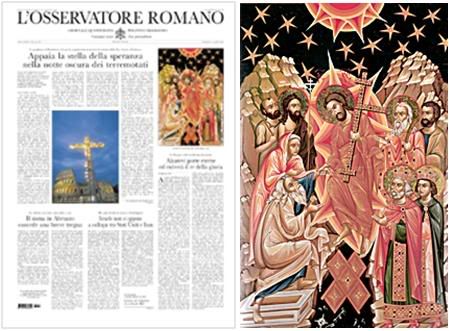
The Pope's prayer for the Abruzzesi at the end of Friday's Via Crucis:
'May the star of hope shine for the earthquake victims'
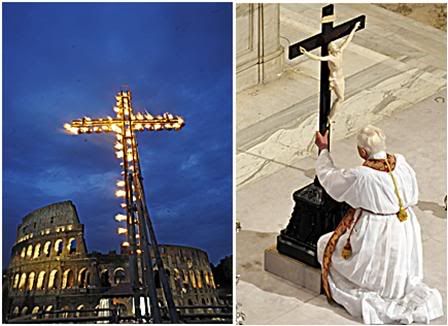
A second story about the earthquake speaks of a day with no aftershocks,
as the death total reaches 291. There is a Page 1 atory on Easter in
the Byzantine tradition, and about israel telling the US there should
be a time limit for its proposed direct talks with iran on the latter's
nuclear weapons program.
LITURGY TODAY

EASTER SUNDAY MASS
10:15 St. Peter's Square
The Holy Father celebrates Mass, to be followed by his Easter message and blessing Urbi et Orbi
from the central loggia of St. Peter's Basilica.
[Modificato da TERESA BENEDETTA 12/04/2009 12:21] |
 12/04/2009 11:58 12/04/2009 11:58 |
|
| | | OFFLINE | | Post: 17.118 | Registrato il: 28/08/2005
| Utente Gold | |
|
 EASTER SUNDAY MASS
EASTER SUNDAY MASS
ST. PETER'S SQUARE
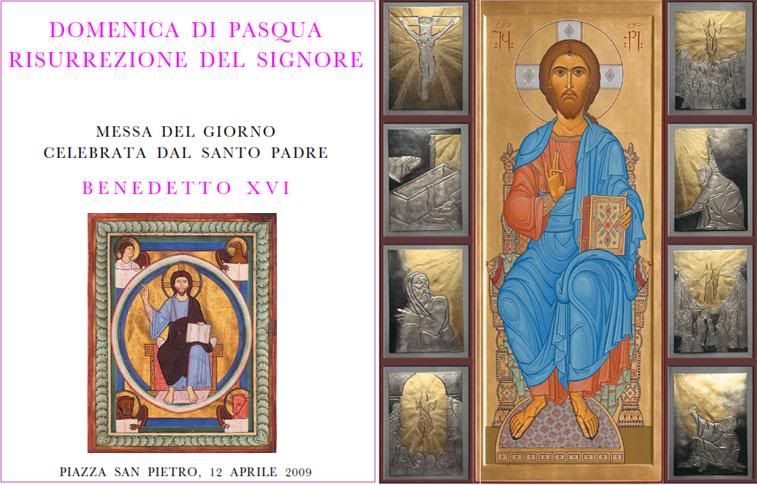
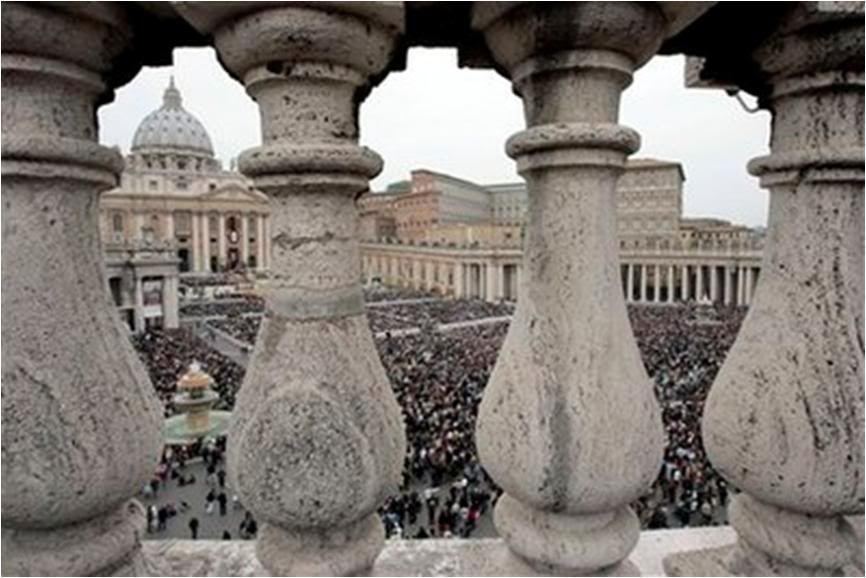

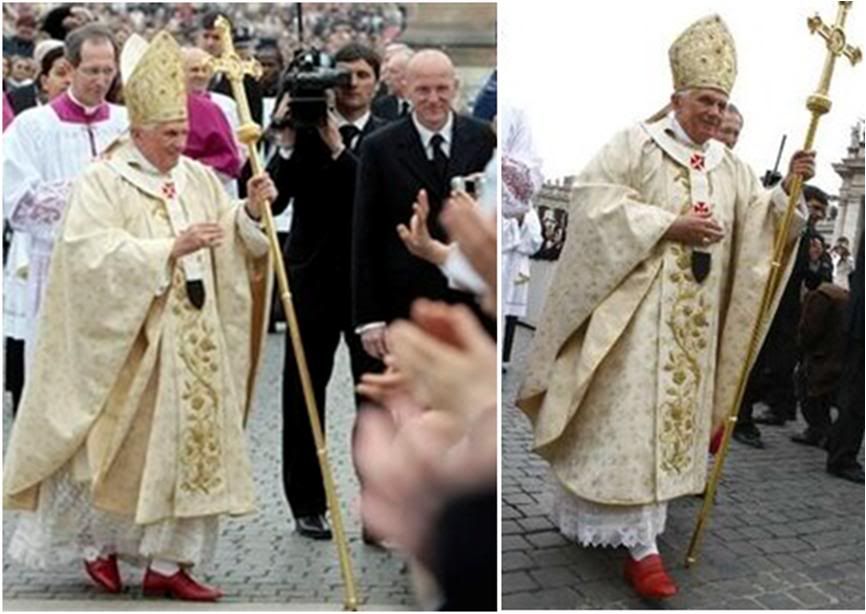

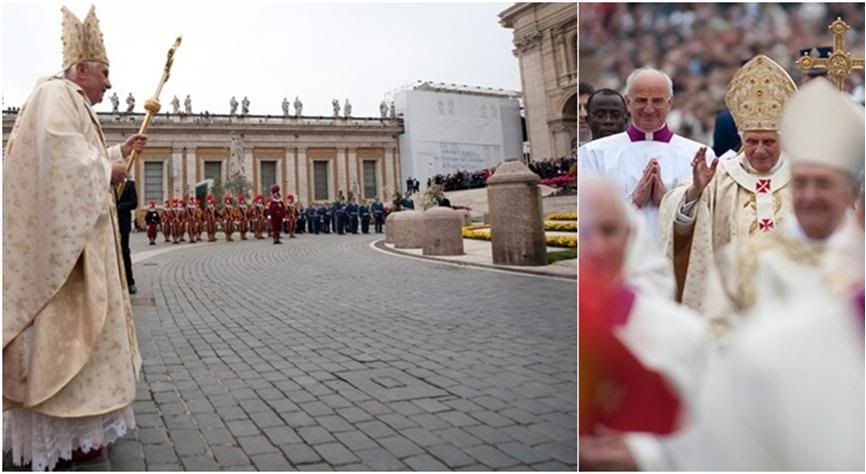
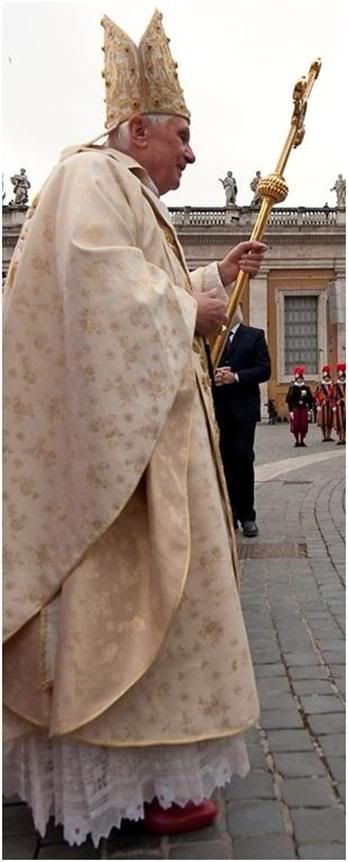 
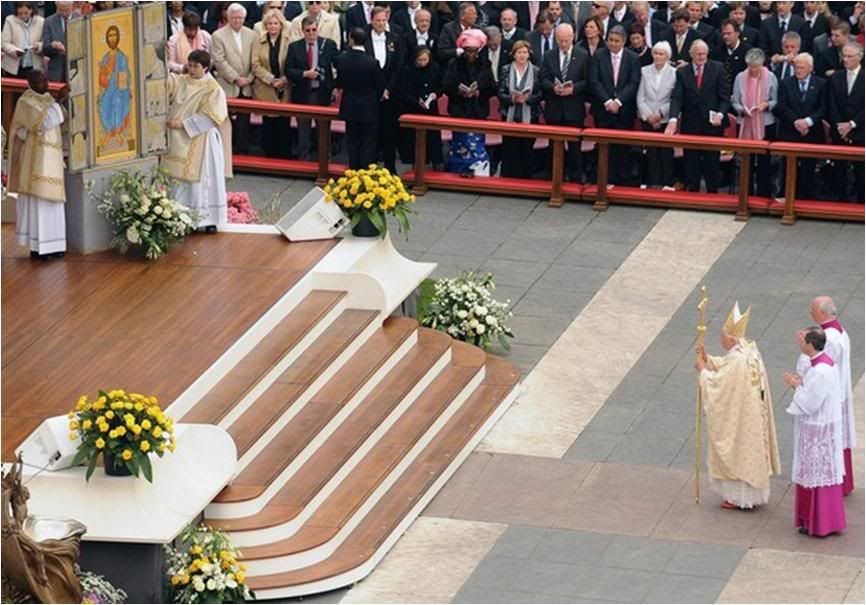
THE HOLY FATHER'S HOMILY
Dear Brothers and Sisters,
"Christ, our Paschal lamb, has been sacrificed!" (1 Cor 5:7).
On this day, Saint Paul’s triumphant words ring forth, words that we have just heard in the second reading, taken from his First Letter to the Corinthians.
It is a text which originated barely twenty years after the death and resurrection of Jesus, and yet – like many Pauline passages – it already contains, in an impressive synthesis, a full awareness of the newness of life in Christ.
The central symbol of salvation history – the Paschal lamb – is here identified with Jesus, who is called "our Paschal lamb". The Hebrew Passover, commemorating the liberation from slavery in Egypt, provided for the ritual sacrifice of a lamb every year, one for each family, as prescribed by the Mosaic Law.
In his passion and death, Jesus reveals himself as the Lamb of God, "sacrificed" on the Cross, to take away the sins of the world. He was killed at the very hour when it was customary to sacrifice the lambs in the Temple of Jerusalem.
The meaning of his sacrifice he himself had anticipated during the Last Supper, substituting himself – under the signs of bread and wine – for the ritual food of the Hebrew Passover meal. Thus we can truly say that Jesus brought to fulfilment the tradition of the ancient Passover, and transformed it into his Passover.
On the basis of this new meaning of the Paschal feast, we can also understand Saint Paul’s interpretation of the "leaven". The Apostle is referring to an ancient Hebrew usage: according to which, on the occasion of the Passover, it was necessary to remove from the household every tiny scrap of leavened bread.
On the one hand, this served to recall what had happened to their forefathers at the time of the flight from Egypt: leaving the country in haste, they had brought with them only unleavened bread. At the same time, though, the "unleavened bread" was a symbol of purification: removing the old to make space for the new.
Now, Saint Paul explains, this ancient tradition likewise acquires a new meaning, once more derived from the new "Exodus", which is Jesus’s passage from death to eternal life.
And since Christ, as the true Lamb, sacrificed himself for us, we too, his disciples – thanks to him and through him – can and must be the "new dough", the "unleavened bread", liberated from every residual element of the old yeast of sin: no more evil and wickedness in our heart.
"Let us celebrate the feast … with the unleavened bread of sincerity and truth". This exhortation from Saint Paul, which concludes the short reading that was proclaimed a few moments ago, resounds even more powerfully in the context of the Pauline Year.
Dear brothers and sisters, let us accept the Apostle’s invitation; let us open our spirit to Christ, who has died and is risen in order to renew us, in order to remove from our hearts the poison of sin and death, and to pour in the life-blood of the Holy Spirit: divine and eternal life.
In the Easter Sequence, in what seems almost like a response to the Apostle’s words, we sang: "Scimus Christum surrexisse a mortuis vere" – we know that Christ has truly risen from the dead. Yes, indeed! This is the fundamental core of our profession of faith; this is the cry of victory that unites us all today.
And if Jesus is risen, and is therefore alive, who will ever be able to separate us from him? Who will ever be able to deprive us of the love of him who has conquered hatred and overcome death?
The Easter proclamation spreads throughout the world with the joyful song of the Alleluia. Let us sing it with our lips, and let us sing it above all with our hearts and our lives, with a manner of life that is "unleavened", that is to say, simple, humble, and fruitful in good works.
"Surrexit Christus spes mea: precedet suos in Galileam" – Christ my hope is risen, and he goes before you into Galilee. The Risen One goes before us and he accompanies us along the paths of the world. He is our hope, He is the true peace of the world. Amen!

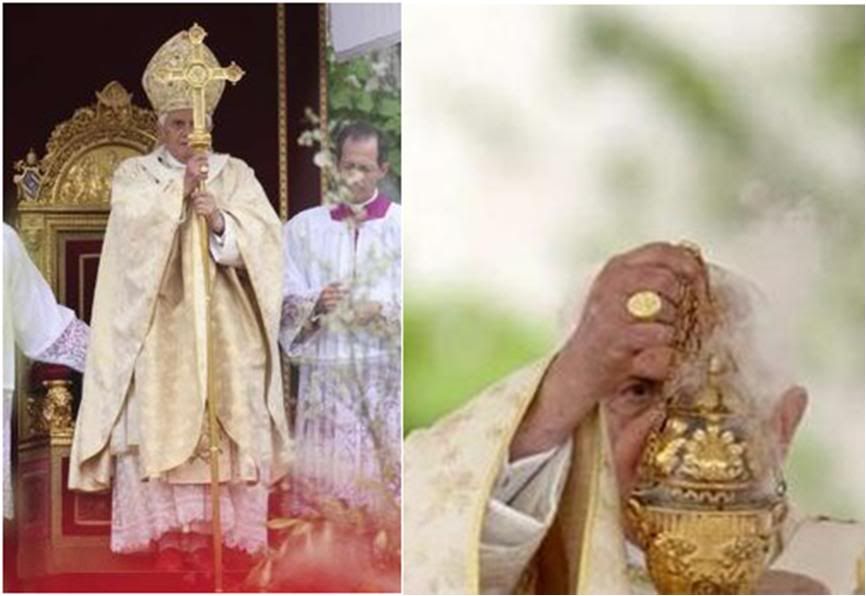
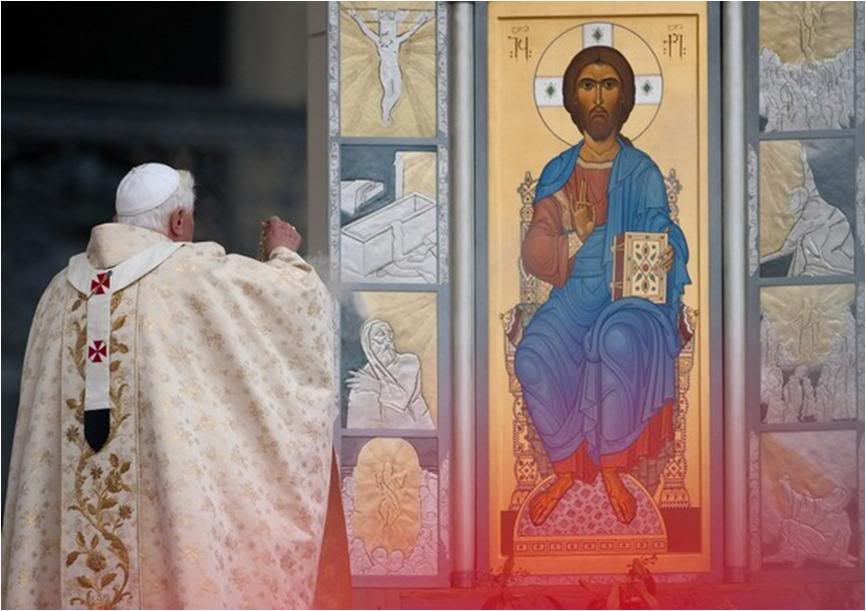
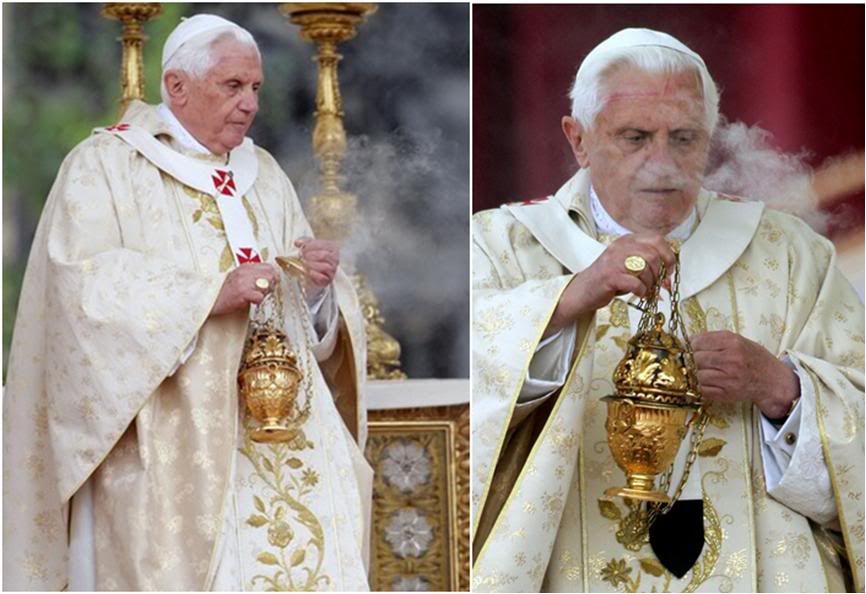


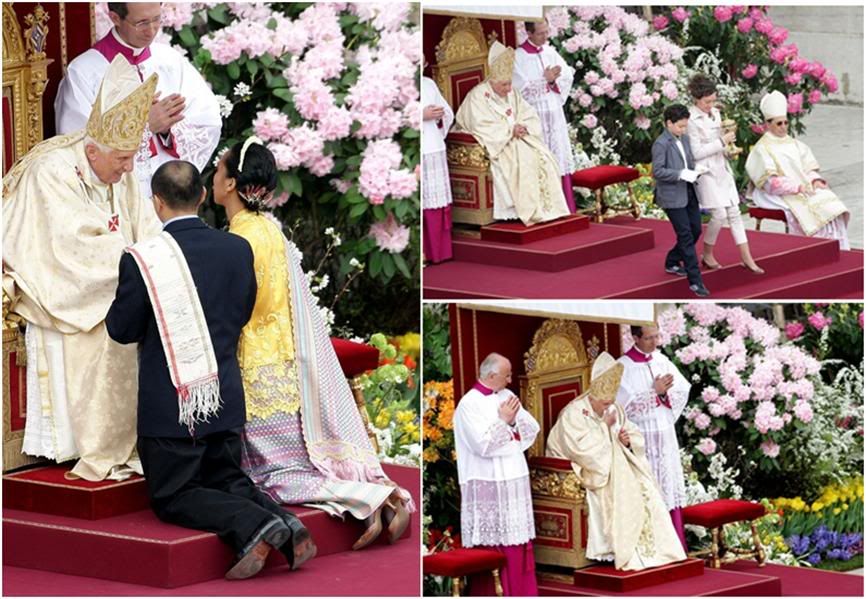
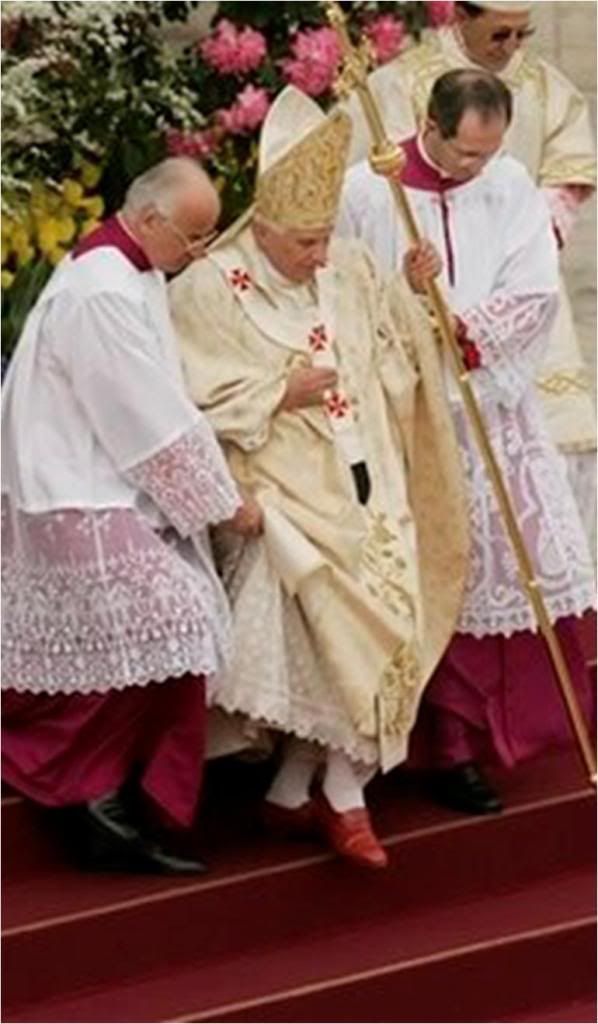 Thanks to Gloria for many of the additional pictures from her forum .
Thanks to Gloria for many of the additional pictures from her forum ..
[Modificato da TERESA BENEDETTA 14/04/2009 03:33] |
 12/04/2009 15:50 12/04/2009 15:50 |
|
| | | OFFLINE | | Post: 17.119 | Registrato il: 28/08/2005
| Utente Gold | |
|
 POPE BENEDICT'S
POPE BENEDICT'S
EASTER MESSAGE 'URBI ET ORBI':
'Rediscover grounds for hope'
By NICOLE WINFIELD

VATICAN CITY, April 12 (AP) — Pope Benedict XVI said today that reconciliation was the only way to resolve the Israeli-Palestinian conflict, and said the entire world needed to rediscover hope to end wars, poverty and financial turmoil.
In his Easter Sunday message, delivered from the central loggia of St. Peter's Basilica, Benedict noted that he plans to travel to the Holy Land in just a few weeks and said he would bring a message of hope and love to the region.
The 81-year-old Pope tripped as he climbed up to his gilded chair on the loggia, but recovered without incident and delivered his speech to the crowds below. [It was a slight trip, which he righted instantly, and he was supported all the time as he climbed the steps to teh chair by his two 'cerimonieri', Monsignors Camaldo and Marini.]
"Reconciliation — difficult but indispensable — is a precondition for a future of overall security and peaceful coexistence, and it can only be achieved through renewed, persevering and sincere efforts to resolve the Israeli-Palestinian conflict," he said.
Benedict delivered his "Urbi et Orbi" speech — Latin for "to the city and the world" — at the end of his Easter Sunday Mass, attended by tens of thousands of people who packed St. Peter's Square and the boulevard leading up to it.
The piazza, decorated with yellow tulips, azaleas and other spring flowers, overflowed with the faithful who came out on an overcast day to celebrate Jesus Christ's resurrection, the most joyous and important day in the Christian church calendar.
The crowd shouted "Benedetto" — Italian for Benedict — as they waited for him to appear at the loggia. They cheered as they awaited his Easter blessing, this year being delivered in 63 languages.
In his first greeting — in Italian — Benedict offered special Easter wishes for the victims of Italy's devastating earthquake, praying that they have "the courage necessary to go forward together to build a future open to hope."
In his speech, Benedict said it was "urgent" to find hope around the globe, despite mounting reasons for despair.
"At a time of world food shortage, of financial turmoil, of old and new forms of poverty, of disturbing climate change, of violence and deprivation which force many to leave their homelands in search of a less precarious form of existence, of the ever-present threat of terrorism, of growing fears over the future, it is urgent to rediscover grounds for hope," he said.
He recalled his recent trip to Africa in urging the faithful to keep up hope to combat poverty and wars.
"Africa suffers disproportionately from the cruel and unending conflicts, often forgotten, that are causing so much bloodshed and destruction in several of her nations, and from the growing numbers of her sons and daughters who fall prey to hunger, poverty and disease," Benedict said.
Benedict celebrated Easter Mass after presiding over the solemn, three-plus-hour Easter Vigil ceremony Saturday night. At the end of that service, Benedict sounded hoarse and looked tired.
But the Pope — who turns 82 on Thursday — appeared well-rested by this morning and held up well throughout the Mass.
He is expected to travel this afternoon to the papal summer retreat in Castel Gandolfo, in the hills south of Rome, for a few days of rest after the busy Holy Week services.
The Pope's May 8-15 Middle East tour, his first to the region as Pope, will include Jordan, Israel and the Palestinian territories, with stops in cities including Amman, Jerusalem, Bethlehem and Nazareth.

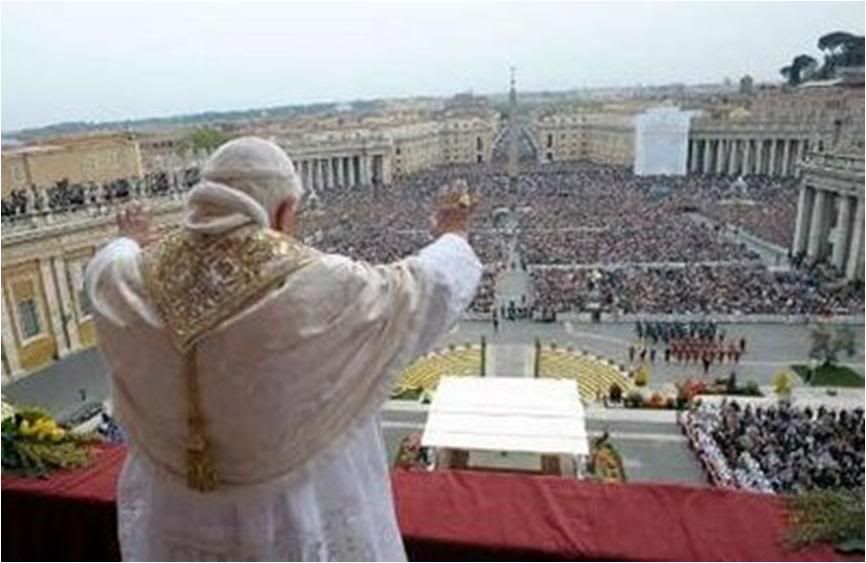
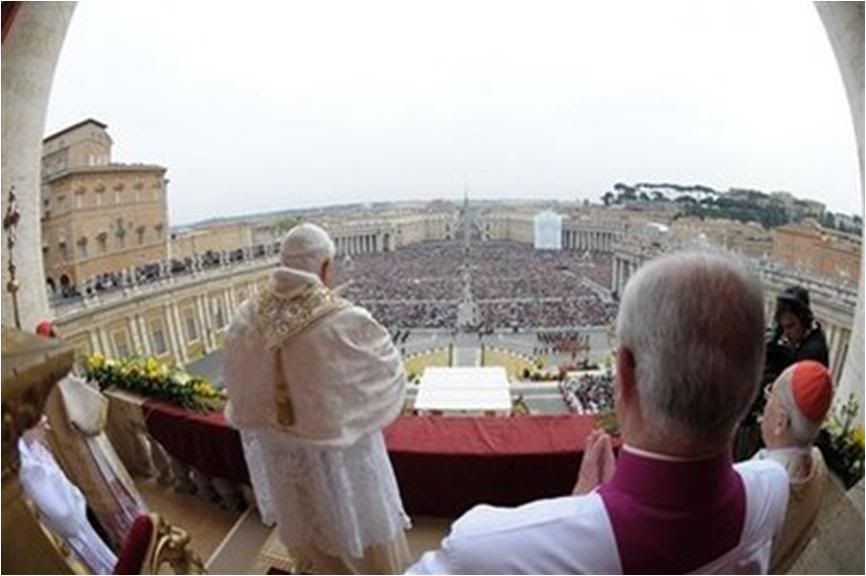
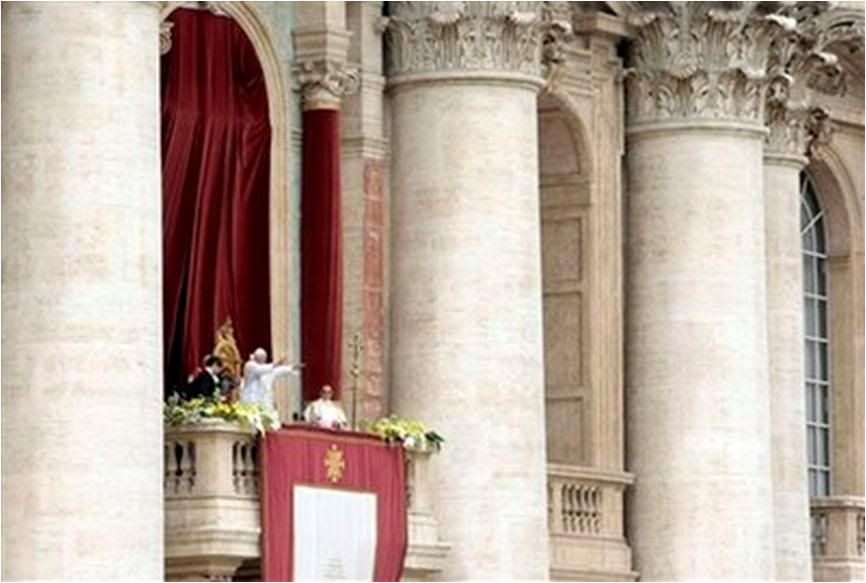 The official translation of the Holy Father's message posted promptly on the regular Vatican press bulletin:
The official translation of the Holy Father's message posted promptly on the regular Vatican press bulletin:
THE HOLY FATHER'S MESSAGE
Dear Brothers and Sisters
in Rome and throughout the world,
From the depths of my heart, I wish all of you a blessed Easter. To quote Saint Augustine, “Resurrectio Domini, spes nostra – the resurrection of the Lord is our hope” (Sermon 261:1).
With these words, the great Bishop explained to the faithful that Jesus rose again so that we, though destined to die, should not despair, worrying that with death life is completely finished; Christ is risen to give us hope (cf. ibid.).
Indeed, one of the questions that most preoccupies men and women is this: what is there after death? To this mystery today’s solemnity allows us to respond that death does not have the last word, because Life will be victorious at the end.
This certainty of ours is based not on simple human reasoning, but on a historical fact of faith: Jesus Christ, crucified and buried, is risen with his glorified body. Jesus is risen so that we too, believing in him, may have eternal life. This proclamation is at the heart of the Gospel message.
As Saint Paul vigorously declares: “If Christ has not been raised, our preaching is in vain and your faith is in vain.” He goes on to say: “If for this life only we have hoped in Christ, we are of all men most to be pitied” (1 Cor 15:14,19).
Ever since the dawn of Easter a new Spring of hope has filled the world; from that day forward our resurrection has begun, because Easter does not simply signal a moment in history, but the beginning of a new condition: Jesus is risen not because his memory remains alive in the hearts of his disciples, but because he himself lives in us, and in him we can already savour the joy of eternal life.
The resurrection, then, is not a theory, but a historical reality revealed by the man Jesus Christ by means of his “Passover”, his “passage”, that has opened a “new way” between heaven and earth (cf. Heb 10:20). It is neither a myth nor a dream, it is not a vision or a utopia, it is not a fairy tale, but it is a singular and unrepeatable event: Jesus of Nazareth, son of Mary, who at dusk on Friday was taken down from the Cross and buried, has victoriously left the tomb.
In fact, at dawn on the first day after the Sabbath, Peter and John found the tomb empty. Mary Magdalene and the other women encountered the risen Jesus. On the way to Emmaus the two disciples recognized him at the breaking of the bread. The Risen One appeared to the Apostles that evening in the Upper Room and then to many other disciples in Galilee.
The proclamation of the Lord’s Resurrection lightens up the dark regions of the world in which we live. I am referring particularly to materialism and nihilism, to a vision of the world that is unable to move beyond what is scientifically verifiable, and retreats cheerlessly into a sense of emptiness which is thought to be the definitive destiny of human life.
It is a fact that if Christ had not risen, the “emptiness” would be set to prevail. If we take away Christ and his resurrection, there is no escape for man, and every one of his hopes remains an illusion.
Yet today is the day when the proclamation of the Lord’s resurrection vigorously bursts forth, and it is the answer to the recurring question of the sceptics, that we also find in the book of Ecclesiastes: “Is there a thing of which it is said, ‘See, this is new’?” (Ec 1:10). We answer, yes: on Easter morning, everything was renewed.
“Mors et vita, duello conflixere mirando: dux vitae mortuus, regnat vivus – Death and life have come face to face in a tremendous duel: the Lord of life was dead, but now he lives triumphant.”
This is what is new! A newness that changes the lives of those who accept it, as in the case of the saints. This, for example, is what happened to Saint Paul.
Many times, in the context of the Pauline year, we have had occasion to meditate on the experience of the great Apostle. Saul of Tarsus, the relentless persecutor of Christians, encountered the risen Christ on the road to Damascus, and was “conquered” by him. The rest we know.
In Paul there occurred what he would later write about to the Christians of Corinth: “If anyone is in Christ, he is a new creation; the old has passed away, behold, the new has come” (2 Cor 5:17).
Let us look at this great evangelizer, who with bold enthusiasm and apostolic zeal brought the Gospel to many different peoples in the world of that time. Let his teaching and example inspire us to go in search of the Lord Jesus.
Let them encourage us to trust him, because that sense of emptiness, which tends to intoxicate humanity, has been overcome by the light and the hope that emanate from the resurrection.
The words of the Psalm have truly been fulfilled: “Darkness is not darkness for you, and the night is as clear as the day” (Ps 139 [138]:12). It is no longer emptiness that envelops all things, but the loving presence of God. The very reign of death has been set free, because the Word of life has even reached the “underworld”, carried by the breath of the Spirit (v. 8).
If it is true that death no longer has power over man and over the world, there still remain very many, in fact too many signs of its former dominion. Even if through Easter, Christ has destroyed the root of evil, he still wants the assistance of men and women in every time and place who help him to affirm his victory using his own weapons: the weapons of justice and truth, mercy, forgiveness and love.
This is the message which, during my recent Apostolic Visit to Cameroon and Angola, I wanted to convey to the entire African continent, where I was welcomed with such great enthusiasm and readiness to listen.
Africa suffers disproportionately from the cruel and unending conflicts, often forgotten, that are causing so much bloodshed and destruction in several of her nations, and from the growing number of her sons and daughters who fall prey to hunger, poverty and disease.
I shall repeat the same message emphatically in the Holy Land, to which I shall have the joy of travelling in a few weeks from now.
Reconciliation – difficult, but indispensable – is a precondition for a future of overall security and peaceful coexistence, and it can only be achieved through renewed, persevering and sincere efforts to resolve the Israeli-Palestinian conflict.
My thoughts move outwards from the Holy Land to neighbouring countries, to the Middle East, to the whole world. At a time of world food shortage, of financial turmoil, of old and new forms of poverty, of disturbing climate change, of violence and deprivation which force many to leave their homelands in search of a less precarious form of existence, of the ever-present threat of terrorism, of growing fears over the future, it is urgent to rediscover grounds for hope.
Let no one draw back from this peaceful battle that has been launched by Christ’s Resurrection. For as I said earlier, Christ is looking for men and women who will help him to affirm his victory using his own weapons: the weapons of justice and truth, mercy, forgiveness and love.
Resurrectio Domini, spes nostra! The resurrection of Christ is our hope! This the Church proclaims today with joy. She announces the hope that is now firm and invincible because God has raised Jesus Christ from the dead.
She communicates the hope that she carries in her heart and wishes to share with all people in every place, especially where Christians suffer persecution because of their faith and their commitment to justice and peace.
She invokes the hope that can call forth the courage to do good, even when it costs, especially when it costs.
Today the Church sings “the day that the Lord has made”, and she summons people to joy.
Today the Church calls in prayer upon Mary, Star of Hope, asking her to guide humanity towards the safe haven of salvation which is the heart of Christ, the paschal Victim, the Lamb who has “redeemed the world”, the Innocent one who has “reconciled us sinners with the Father”.
To him, our victorious King, to him who is crucified and risen, we sing out with joy our Alleluia!
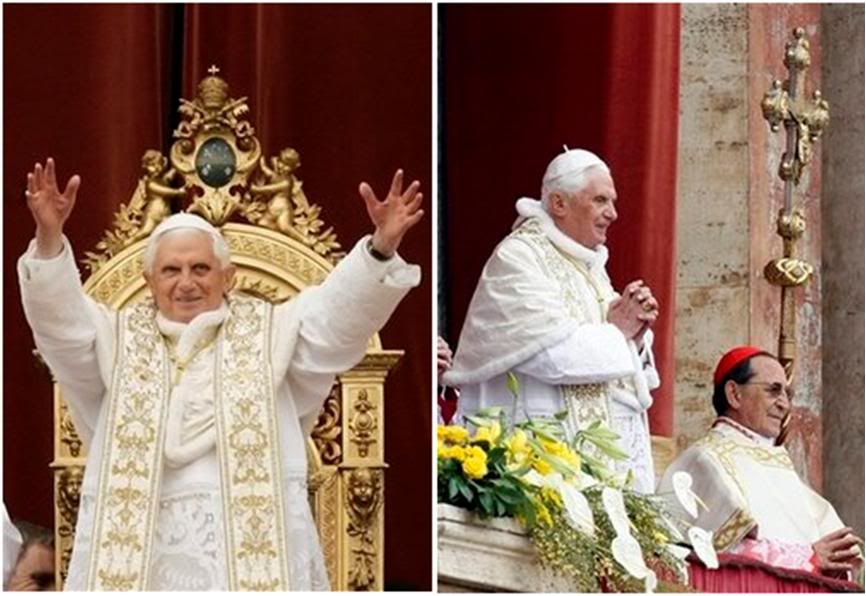



NB: I believe it is the first time Pope Benedict has worn the white Easter mozzetta for the Easter U&O. He started wearing the Easter mozzetta last year.
Also, as at last Christmas, it appears he has decided to stop wearing the papal cope and miter for these greetings from the loggia - I suppose it makes sense because when a new Pope first makes his appearance 'urbi et orbi' (to the city and to the world'), he is dressed in mozzetta, stole and choir robe, as the Pope was today.
[Modificato da TERESA BENEDETTA 14/04/2009 03:04] |
 13/04/2009 12:28 13/04/2009 12:28 |
|
| | | OFFLINE | | Post: 17.121 | Registrato il: 28/08/2005
| Utente Gold | |
|
[Modificato da TERESA BENEDETTA 13/04/2009 12:36] |
 13/04/2009 12:33 13/04/2009 12:33 |
|
| | | OFFLINE | Post: 1.835 | Registrato il: 27/11/2005
| Utente Veteran | |
|
A very fine day here in England - let's hope it's as bright in CG!
Thank you, Teresa, for your excellent and quickly updated coverage of all last week's events, including photos of the Mass at L'Aquila. I am particularly delighted to have pictures of the covers of the liturgy books, because they are only available to those who are present. |
 13/04/2009 12:35 13/04/2009 12:35 |
|
| | | OFFLINE | | Post: 17.122 | Registrato il: 28/08/2005
| Utente Gold | |
|

April 13
 St. Martin I (+651)
St. Martin I (+651)
Pope and Martyr
No OR today.
THE POPE'S DAY
The Holy Father went to Castel Gandolfo yesterday afternoon for a brief period of rest after the Holy Week events.

At noon today, he led the Regina Caeli in the inner courtyard of the Apostolic Palace, on the occasion of
'Angel's Monday', a festivity observed in many countries including Italy to recall the angel who informed
the women at the tomb that Christ had risen.
[Modificato da TERESA BENEDETTA 14/04/2009 03:47] |
 13/04/2009 14:04 13/04/2009 14:04 |
|
| | | OFFLINE | | Post: 17.124 | Registrato il: 28/08/2005
| Utente Gold | |
|
 'REGINA CAELI' TODAY
'REGINA CAELI' TODAY
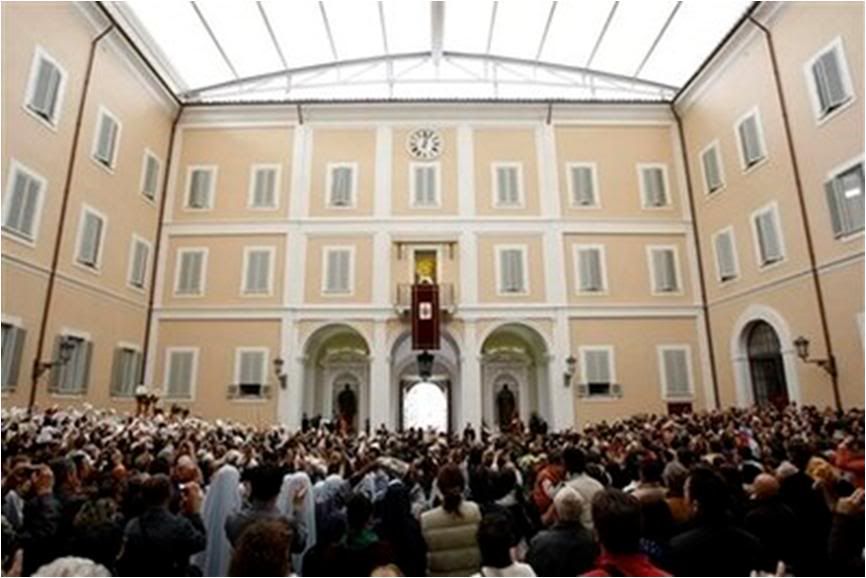
 Here is a translation of the Holy Father's words at the 'Regina caeli' today in Castel Gandolfo:
Here is a translation of the Holy Father's words at the 'Regina caeli' today in Castel Gandolfo:
Dear brothers and sisters!
During these days of Easter, we shall often recall the words of Jesus
"I have resurrected and will always be with you".
Echoing this announcement, the Church proclaims exultantly: "Yes, we are sure! The Lord has truly risen again, alleluia! Glory and power to him forever!" It is the whole Church in celebration that manifests its sentiments singing,"This is the day of Christ the Lord."
In effect, by rising from death, Jesus inaugurated his eternal day. "I will not die," he says, "I will remain alive".
The Son of Man, crucified, a stone cast off by the builders, became the solid foundation of the new spiritual edifice, which is the Church, his mystical Body.
The people of God, with Christ as their invisible head, was destined to grow in the course of centuries, until the final fulfillment of the plan of salvation - when all of mankind shall be incorporated into him, and every existing reality will be compenetrated by his total victory.
At that time, as St. Paul writes, he will be "the fullness of the one who fills all things in every way" (cfr Eph 1,23), and "God will be all in all" (1 Cor 15,28).
The Christian community rejoices because the resurrection of the Lord assures us that the divine plan of salvation will surely be fulfilled. That is why Easter is truly our hope.
And we, who are resurrected with Christ in Baptism, should follow him faithfully in holiness of living, walking without a pause towards the eternal Easter, sustained by the awareness that the difficulties, struggles, trials and sufferings of human existence, including death, will then no longer separate us from him and his love.
His resurrection has laid a bridge between the world and eternal life, a bridge over which every man and woman must pass to reach the true goal of our earthly pilgrimage.
"I have arisen and are always with you". This assurance by Jesus is realized above all in the Eucharist. It is in every celebration of the Eucharist that the Church - and every member of it - experiences his living presence and benefits from all the richness of his love.
In the sacrament of the Eucharist, the risen Lord purifies us of our sins; he nourishes us spiritually and infuses us with vigor to withstand the hard trials of existence and to fight sin and evil.
He is the sure support for our pilgrimage towards the eternal dwelling in heaven. May the Virgin Mary, who lived with her divine Son every phase of his mission on earth, help us to accept with faith the gift of Easter and make us faithful and joyful witnesses of the risen Lord.
After the recitation of the Regina Caeli, the Holy Father, as usual, gave greetings in various languages. In English, he said:
I am pleased to welcome all the English-speaking pilgrims to this Regina Caeli.
My dear friends, our song of joy on the night of Jesus’s Resurrection – "Rejoice heavenly powers! Exult all creation!" – continues to resound throughout these eight days of solemn celebration.
The Lord of heaven and earth has arisen in glory! His splendour continues to shine upon the human race, giving strength to the weak, relief to the suffering and comfort to the dying.
I pray that Christ’s gift of new life will grow in your hearts and lead you along the way of eternal salvation. God bless you all!
[Modificato da TERESA BENEDETTA 14/04/2009 03:48] |
 14/04/2009 01:34 14/04/2009 01:34 |
|
| | | OFFLINE | Post: 3.770 | Registrato il: 23/11/2005
| Utente Master | |
|
Israel launching Web site for papal visit
April 13, 2009
NEW YORK (JTA) -- The Israel Ministry of Tourism is launching a Web site dedicated to Pope Benedict XVI’s visit to Israel in May.
The site, www.holyland-pilgrimage.org will be launched Wednesday and be available in seven languages. It will feature background information, photographs and video footage related to Christian holy sites in Israel, as well as detailed information on the pope's itinerary and trip highlights.
Benedict is making his first visit to Israel. His May 8-15 trip also includes stops in Jordan and the Palestinian territories.
[Modificato da benefan 14/04/2009 01:35] |
 14/04/2009 12:51 14/04/2009 12:51 |
|
| | | OFFLINE | | Post: 17.125 | Registrato il: 28/08/2005
| Utente Gold | |
|
 For all intents and purposes, we are entering the fifth year of Benedict XVI's Pontificate, Deo gratias, even though April 19 is still a few days away.
For all intents and purposes, we are entering the fifth year of Benedict XVI's Pontificate, Deo gratias, even though April 19 is still a few days away.
While the Italian papers observed Angel's Monday today without without coming out (and so OR does not have a Tuesday issue either), Le Figaro today (Monday, 4/13/09) has a 'major' article on Benedict's Pontificate - even if it continues to perpetrate the media's own myths. It is unfortunate that what passes for analysis is little more than a superficial recapitulation of exhausted but ingrained biases, with no attempt at analytical distance.
Interestingly, the caption contains a much better analysis, and the sub-head states a fact that is not mentioned in the article itself! Here is a translation:
BENEDICT XVI'S VIA CRUCIS
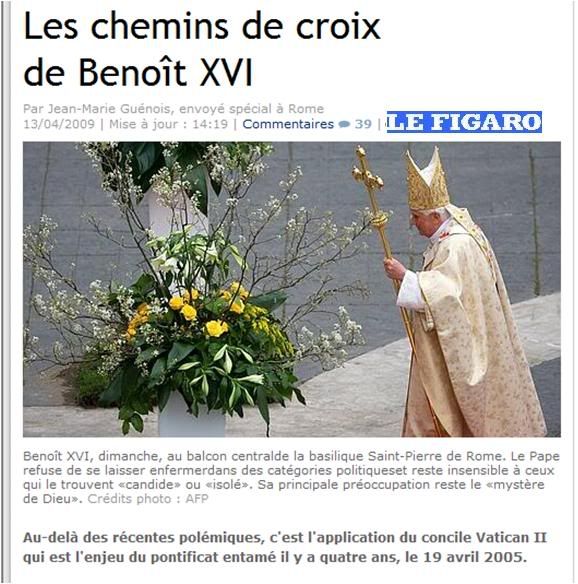
[Caption]: Benedict XVI, Sunday, on the central balcony of St. Peter's Basilica in Rome. [OObviously not!] The Pope rufuses to be enclosed within political categories and remains impervious to those who find him 'naive' or 'isolated'. His principal concern remains 'the mistery of God'. [AFP photo]
Beyond recent controversy, it is the application of Vatican II which is the principal stake of the Pontificate which began four years ago, on April 19, 2005.
Last Friday night, Benedict XVI carried the Cross. The Via Crucis at the Colosseum had a very special significance for him. On the eve of his 82nd birthday, on April 16, he had just undergone the most violent tempest in the four years of his Pontificate, begun on April 19, 2005.
The succession in this first three months of the year, of three 'cases' - lifting the excommunication of four Lefebvrian bishops of which one is a Holocaust denier; the issue over the 9-year-old Brazilian girl whose twin pregnancy resulting from rape by her stepfather was aborted [an 'issue' that seemed to have 'caught on' only in France outside of Brazil]; and the Pope's statements on condoms and AIDS in Africa - all brought unprecedented trouble within the Church as outside it. [An exaggeration that reflects the media-generated inflation of these situations!] - a sort of crisis in confidence which has led some to question the credibility of Benedict XVI. [Typical MSM set-up to convey a fallacious impression as being more 'widespread' than within the proponent's biased milieu!]
The three cases may have nothing to do with such a crisis but together they do provoke the same reflex accusations. [Well, at least he uses the term 'reflex accusations; himself - if that's not an admission of bias, what is?]
All such accusations are directed at 'the Vatican', 'the Pope's entourage', or 'the theologian Pope' - in short, it is Rome that is the source of all evils.
But a visit this Holy Week to the 'arcanities' of the Vatican - Italian observers, workers in the Curia, cardinals, personages close to teh Pope who require anonymity in order to speak the truth - makes it appear that these three cases have also served to highlight three structural problems that weigh on Benedict XVI - his three 'crosses', in effect.
The first, if it were not just a series of gaffes, would be fatal. Counter examples are abundant in his pontificate, but the three instances make it appear as if Benedict XVI obtains the exact opposite of his intended objective.
In wanting to lift the excommunication of the bishops illicitly ordained by Mons. Lefebvre, the Pope - who has primary responsibility for the unity of the Church - sought to eliminate the risk of a lasting schism.
But instead of 'unity', he only reaped profound division because of the negationist statements of Mons. Williamson's negationism which was well-known in the Vaticanbut about which no one informed the Pope. [The statement contains two assertions that serve to reinforce the very impression the writer seemingly intends to counteract! Vehement dissent by some European bishops does not constitute 'profound division' in a Church with 1.2 billion members, and Williamson's negationism was obviously not 'well-known' in the Vatican!
The only previous public statement by Mons. Williamson to his weird beliefs was in 1989 in Canada - and no references to it were available online until after the January 21 airing of his interview with Swedish TV. But the critics have now successfully crated teh myth that this information was always available! And by the way, equally important, neither was there a single account of outrage by anyone - Jews and media included - about Williamson's negationism before January 21, 2009. Swedish TV could have made a big to-do about it when they first got the interview in November 2008, but they chose to keep it under wraps!]
As for condoms and AIDS, he took a risk by stigmatizing anti-AIDS campaigns based solely on condom use - something John Paul II never did. His statements as reported incompletely [Thank you for acknowledging that!] gave the impression that the Church continues to reject a means recognized by medicine to reduce a mortal epidemic even if ti is not 100% reliable. [Again, the statement cleverly conveys an untruth as fact, when studies publicized after the Pope's statements show that condoms succeed in cutting down AIDS spread only among the three high-risk populations - prostitutes, homosexuals and drug addicts - who certainly do not constitute the majority of AIDS patients in Africa!] Thus, they say, the Pope is a positive accomplice to sowing death. {But that is the impression most of the media reporting tended to create - some even say so explicitly, 'quoting' critics, of course - and the impression Guenois himself continues to perpetrate in these statements.]
Paradoxically, Benedict XVI appears to recognize - implicitly, but for the first time - the possibility of using condoms as prophylaxis! The best proof came, four days after the Pope's statements, through a Page 1 article in L'Osservatore Romano, the newspaper of the Holy See.
It recounted the experience in Uganda where a campaign based on advocating monogamous faithfulness in couples, abstinence among young unmarried persons and the condom for certain high-risk groups (homosexuals, prostitutes, drug addicts).
[Oh, here he cites what I just cited but in a totally perverse way. Obviously, for purposes of Church teaching, the sexual practices engaged in by these three groups are obviously not for procreation in any way, and would impose the practical obligation on the part of these groups to protect themselves! The Church opposes the use of condoms for contraception, and therefore, implicitly, only among married couples. Unmarried couples using condoms are sinning already by engaging in sex outside marriage, so their use of condoms is not really the question! How can this not be obvious to anyone who takes a moment to think about it?]
Uganda has had the best results in Africa with its campaign against AIDS, dropping down from an AIDS infection rate of 15% of the population to 5% in ten years (1991-2001).
Above all, the article was not published at random: it received, before it was published, the go-ahead from teh highest doctrinal authority of the Vatican, teh Congregation of or the Doctrine of the Faith. [Here, Guenois is playing naive deliberately. The Church has always cited the Ugandan ABC campaign as an example, even if it was largely unreported in a Western world that is so invested so wrongheadedly in the condom as the only anti-AIDS 'strategy' worth considering. And it certainly does not need the CDF to sanction reporting objective fact!!!!]
Benedict's second 'Cross' is internal. It is a divided Roman Curia. Opposing currents - or even 'parties', the term Italians prefer - have always existed there. But the division sharpened with the Williamson case, which was considered extremely toxic and where interested parties have not stopped measuring the harm it has caused.
[What harm exactly? Except for reinforcing the un-Christian attitude of sanctimonious types who are more concerned with the good opinion of Jews rather than seeing that Williamson's unfortunate views are simply an individual failing - like we all have - for which he alone, Williamson, is answerable (just as each of us alone is answerable for our own sins and failings), and not the Church!
There's a complete loss of perspective in this whole matter, in which the Holocaust is made to appear like a dogma of faith. That it is historical fact does not make it an article of faith!
Williamson is obviously wrong in what he believes - the more improbable because he seems to be otherwise a person whose intelligence is above average. But look at the super-intelligent persons, too, who believe in the infallibility of their global warming catastrophism, ignoring the cyclicity of global temperature conditions over centuries and eons, as well as shorter-term data such as those of the past 100 years which tend to contradict their catastrophism!]]
But the malaise is wider. The principal target appears to be the Secretary of State, Cardinal Tarcisio Bertone. This 'prime minister', who will turn 75 this year, has the full confidence of the Pope, dating from when he was Cardinal Ratzinger's #2 man for some time at the CDF.
The tandem was well-oiled. And the Pope, who prefers to work on his theology alone, completely trusted him to run the Vatican's complex machinery. But this Salesian is resented for not having come through the Vatican's prestigious diplomatic route, the Roman 'academy' which trains nuncios and has provided the Vatican with its secretaries of state. [Isn't it surprising that Guenois fails to flesh out the anti-Bertone factionalism in any way? The charge is worse now than merely being an outsider - it is that he has failed to exercise any control of teh Curia at all, much less of the Secretariat of Satte itself.]
The last trial for Benedict XVI is to remain symbolically as John Paul II's 'successor' [an impression media reinforces daily - the Pope, any Pope, is the Successor of Peter, not the successor of his immediate predecessor!]
Even after four years, he continues to be compared to him, consciously or unconsciously. More so in a time of crisis. The statue of the charismatic giant is there to cast a shadow .[This is the mind-set of those who cannot conceive that it is possible to have two great Popes in succession. All Catholics should be proud that the Church, at this time, had Karol Wojtyla and Joseph Ratzinger to lead the Church.
John Paul II's greatness should not in any way diminish or detract from Joseph Ratzinger's sterling qualities and a greatness that does not rest on 'charisma' as the media sees it, but on genuine charism in the sense of grace from the Holy Spirit.]
Benedict XVI is self-deprecating and does not have his predecessor's mediatic qualities. [He certainly does, but they are of a different kind - and media only recognize showman-type charisma, it seems. If the 'media' existed as they do today in Jesus's time, would they have found him 'charismatic' at all? Or would they have dismissed him as nothing more than 'a mild-mannered country rabbi preaching along the dusty roads of Galilee', as revisionist historico-critical accounts reduce him?]
Benedict XVI, it is said, rejects 'false personalization' [I don't recall in four years of trying to look at everything I can about him that he ever used the term.What he does say all the time and in many different ways is that he is not presenting himself or his message - but Christ and his message.] He wants to disappear behind his function. But this is an a priori devaluation in terms of image. ['Mais c'est une dévalorisation a priori en terme d'image' - I dont know exactly what Guenois means by this!]
These three problems - communication, government and a nostalgia for the Pope-star [Wait! Didn't most of the media hail Benedict as a 'superstar' during his triumphal visits to Cologne, the United Sattes and Australia? - The media bias is weird, because they did not apply the same 'verdict' to his equally triumphal visits to Poland (where John Paul's compatriots showed the world what genuine veneration is for a Pope, even one who 'replaced' their own!), Bavaria, France, and most remarkably, Africa!] -
have evoked floods of commentary in Rome but are still, according to better informed observers, confined to the periphery and do not affect the man at the center himself.
They suggest to observe the Pope himself during all these controversies and to take better consideration of the Church's global and historical reach. [But does any fair-minded journalist need this to be pointed out? The answer may be that there hardly is any fair-minded journalist out there reporting on the Pope and the Church!]
********************************************************************
I had a very unfortunate surprise at work this Easter Monday. The hospital has barred access to certain Internet sites, which include all blogs and forums, so although I can check regular news sites and the Vatican site itself, I am unable to access the Forum at work now, so i cannot enter anything during the day, and this will, of course, further limit what I can do on the Forum. It's time for some changes, anyway.
[Modificato da TERESA BENEDETTA 14/04/2009 14:01] |
 14/04/2009 13:38 14/04/2009 13:38 |
|
| | | OFFLINE | | Post: 17.127 | Registrato il: 28/08/2005
| Utente Gold | |
|

April 14
 St. Peter Gonzalez (1190-1246)
St. Peter Gonzalez (1190-1246)
Popularly known as St. Elmo
Spanish Dominican
Patron Saint of Sailors
No OR today.
It appears from the Italian TV schedules that the Holy Father will hold a General Audience tomorrow,
most likely at St. Peter's Square, although he will remain in Castel Gandolfo till the weekend.
He is scheduled to meet with the Franciscan community at Castel Gandolfo on Saturday in connection
with the 800th anniversary of the foundation of the order.
|
 14/04/2009 14:08 14/04/2009 14:08 |
|
| | | OFFLINE | | Post: 17.128 | Registrato il: 28/08/2005
| Utente Gold | |
|
 A belated post, I'm sorry. But the news here would beif Cardinal pell had taken a different position!
Cardinal Pell backs Pope's
A belated post, I'm sorry. But the news here would beif Cardinal pell had taken a different position!
Cardinal Pell backs Pope's
position on condoms

April 10, 2009
The head of the Catholic Church in Australia, Cardinal George Pell, says he agrees with the Pope's recent comments about condoms aggravating the AIDS problem.
On a trip to Cameroon and Angola in March, Pope Benedict XVI sparked backlash by saying condoms are aggravating the African epidemic rather than containing it.
Cardinal Pell, Sydney's Catholic Archbishop, has told Sky News that reliance on condoms contributes to the problem because they are not always reliable and because they increase sexual activity outside of marriage.
"They're encouraging promiscuity because they're encouraging irresponsibility," he said.
"The idea that you can solve a great spiritual and health crisis like AIDS with a few mechanical contraptions like condoms is ridiculous."
Cardinal Pell also cited the difference in HIV infection rates between Catholic and non-Catholic countries as evidence that condoms are ineffective.
"If you look at a country like the Philippines which is Catholic, the infection rate with AIDS is much lower there than it is, for example, in Thailand, which is awash with condoms," he said.
Cardinal Pell also said a non-Catholic health worker, with whom he had travelled back from a trip to Africa, had told him condoms were not an effective solution to Africa's AIDS problem.
"He made the point that the people in remote areas are too poor to afford condoms and the ones that are available are often of very poor quality and weren't used effectively," he said.
The comments come as hundreds of Catholics attended the Stations of the Cross service for Good Friday at St Mary's Cathedral in central Sydney.
|
 14/04/2009 16:17 14/04/2009 16:17 |
|
| | | OFFLINE | | Post: 17.129 | Registrato il: 28/08/2005
| Utente Gold | |
|
 Pasch*, poverty and peace:
Pasch*, poverty and peace:
Papa Ratzinger's 3 P's
by Luigi Accattoli

April 14, 2009
*The Italian word for Easter is Pasqua, and ex-Vaticanista Accattoli carries on as a contributor to the daily newspaper Libero, for which he writes these commentaries in the form of a 'letter to the editor'.
Dear Editor,
Three weeks after his return from the trip to Africa and a month before his pilgrimage to the Holy Land, Benedict XVI raised once again, on Easter Sunday, his cry for peace for the dark continent and the Middle East, both tormented by 'interminable conflicts' and very much in need of 'indispensable reconciliation'.
I find it highly significant that the theologian Pope - whom perhaps we all imagine to be rather more focused on words than on deeds - is instead linking, with increasing efficacy, his preaching to events within and outside his pontificate.
The two trips which are symbolic of this spring for the Pope and the global economic crisis are the principal events that preoccupy him at this time.
One must pay attention to the elements in the African and Middle Eastern situations that he recalled in his Urbi et Orbi Easter message, in order to understand the lesson he drew from his trip to Cameroon and Angola and how he is preparing for the trip he is making to Jordan, Israel and the Palestinian territories in May.
The unarmed prophet is investing energy and commitment into his trips that are quite remarkable, perhaps far more than he had expected to do when he first became Pope.
The Pope affirms that the troubles of the world must be faced by Christians with 'the weapons of justice and truth, of mercy, of forgiveness and of love". Our prophet cannot present himself more disarmingly.
He said that 'this was the message' that he had intended to convey in his recent mission 'to the entire African continent' which received it "with great enthusiasm and a willingness to listen".
Here one can sense a comparison - not expressed by the Pope - to how his African mission had been received (more correctly, not received) by the richer nations.
With moving words, Benedict XVI reiterated his advocacy for the cause of Africa from the central Loggia of St. Peter's, as he had done tirelessly for a week in the stadiums and churches of Yaounde and Luanda.
Because, he said, mankind in that continent "suffers disproportionately from the cruel and interminable conflicts, often ignored, that tear apart and have shed blood in many of its nations and for its growing number of sons and daughters who end up being prey to hunger, poverty and disease".
The Pope had gone to Cameroon and Angola, among other things, to call the world's attention to the continent, "so that men and women in all parts of the world may turn their eyes to Africa... so thirsty for justice and peace". And doubtless, he will say the same about the Middle East.
On Easter Sunday, he pointed out this parallel between his two missions: "I will repeat the same message in the Holy Land, where I will have the joy of visiting within a few weeks. The difficult but indispensable reconciliation which is the premise for a future of common security and peaceful coexistence, cannot become reality without the renewed, persevering and sincere efforts to resolve the Israeli-Palestinian conflict".
Benedict XVI anticipates that from Amman, from Jerusalem, from Bethlehem, he will be addressing all of mankind: "From the Holy Land, we can look out to the surrounding nations, on the Middle East, on the whole world".
It will be a global message that will not keep silent on any of the tragedies of our day, from the economic crisis to climate change, from apocalyptic migrations to the geographies of hunger and of terrorism.
"In a time of global food shortage," he emphasized rightly, "and of financial chaos, of new and old poverties, of worrisome climate changes, of violence and poverty that constrain many to leave their own lands in search of a less uncertain survival' of an ever more threatening terrorism; of growing fears in the face of tomorrow's uncertainties - it is urgent to rediscover perspectives that can restore hope."
We can imagine that Pope Benedict has already been working on his texts for his pilgrimage to the Holy Land and that he will use the occasion to frame his discourses as an appeal to the entire international community so that everyone may be engaged in helping to resolve the Middle East tragedy, and from such engagement, learn to be similarly engaged in the other tragedies on the world stage.
|
|
|
|
|